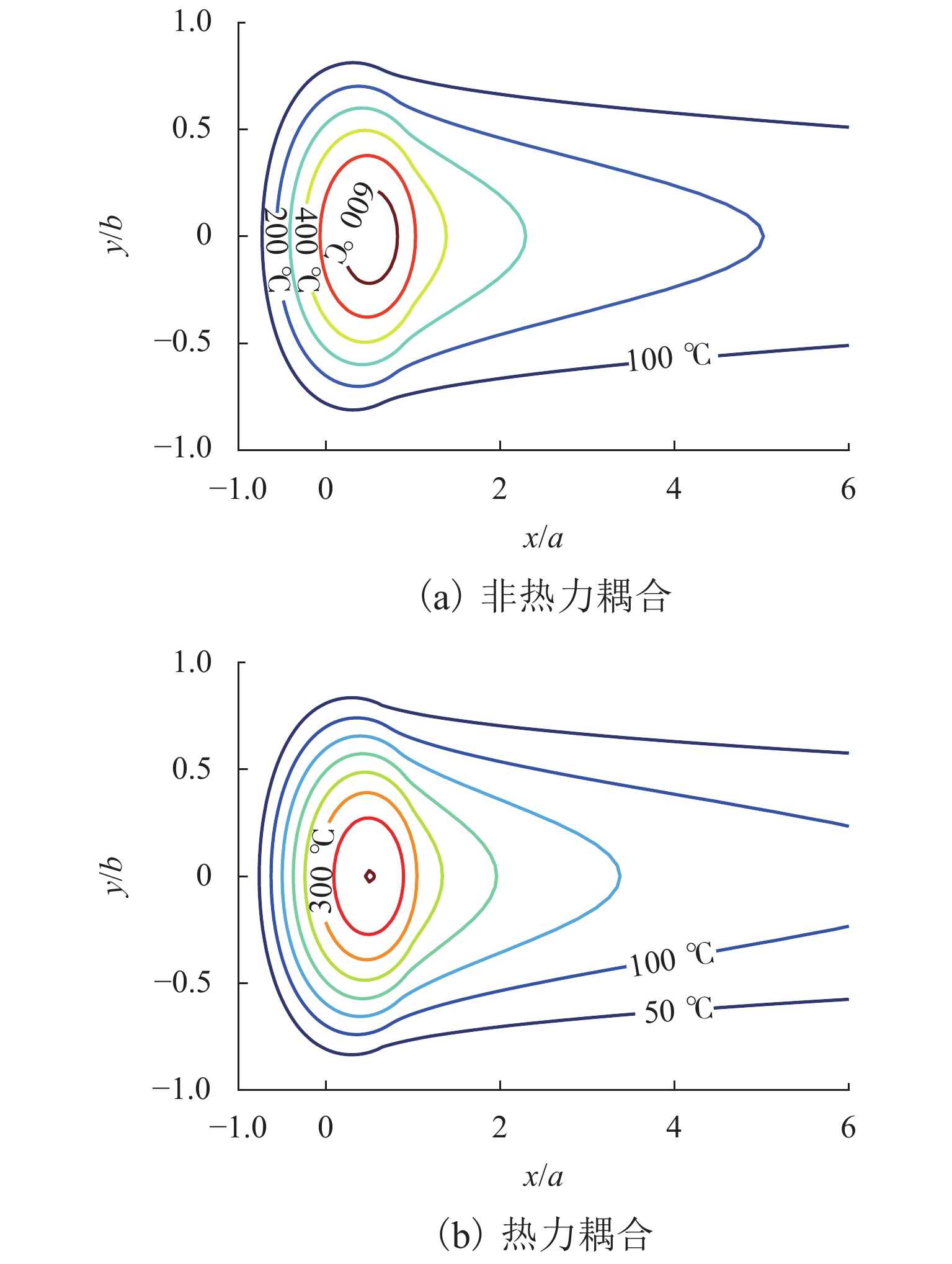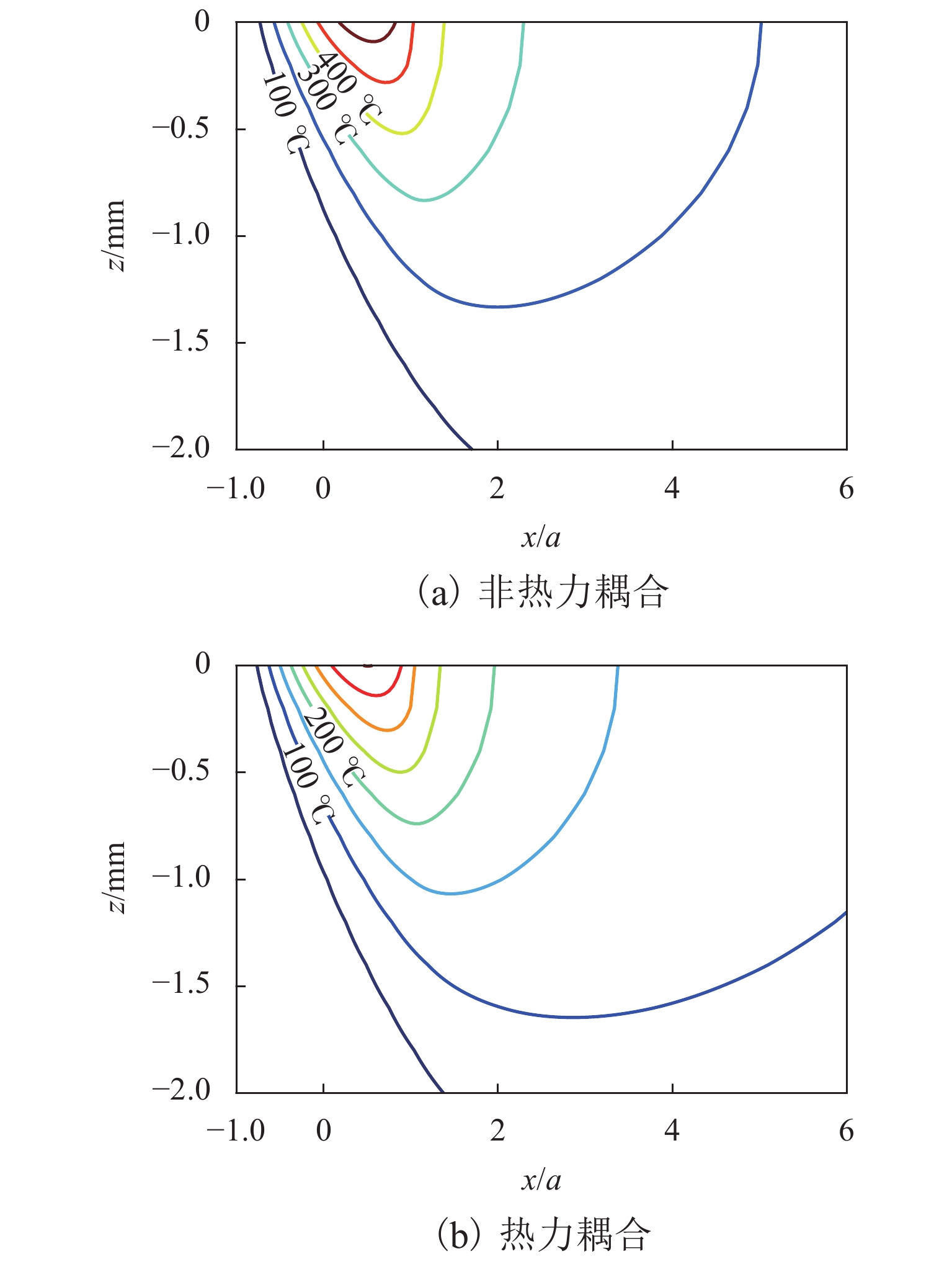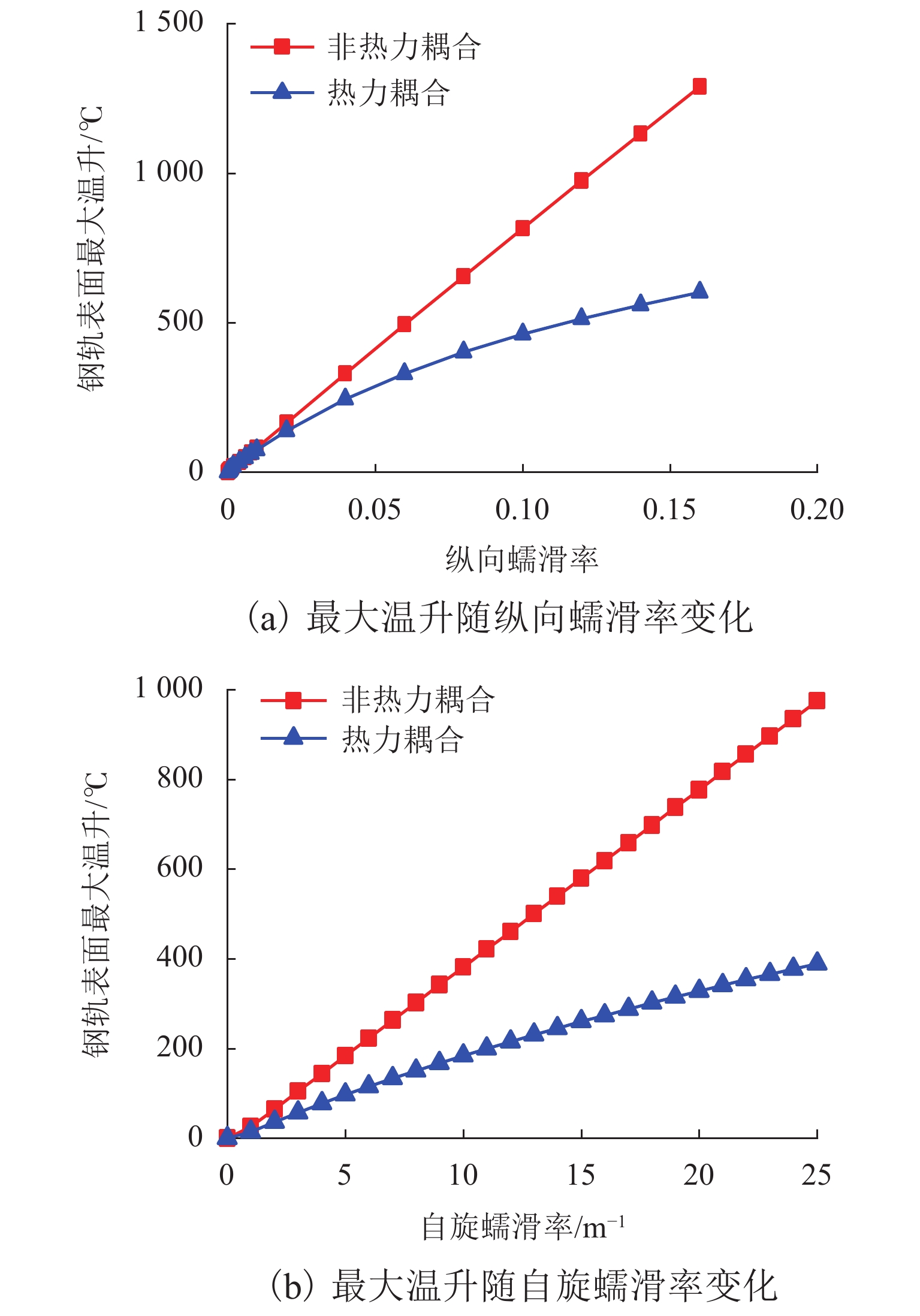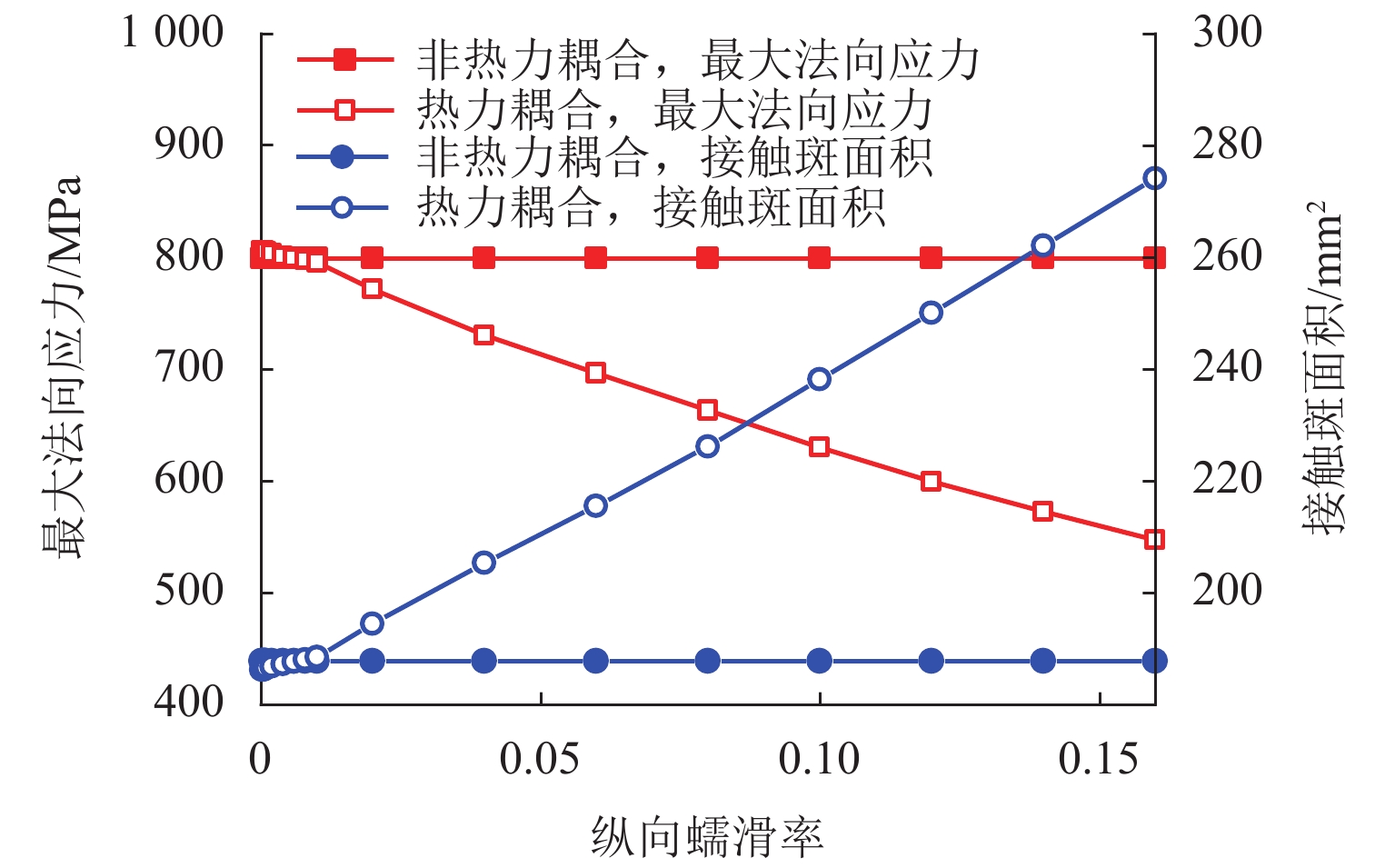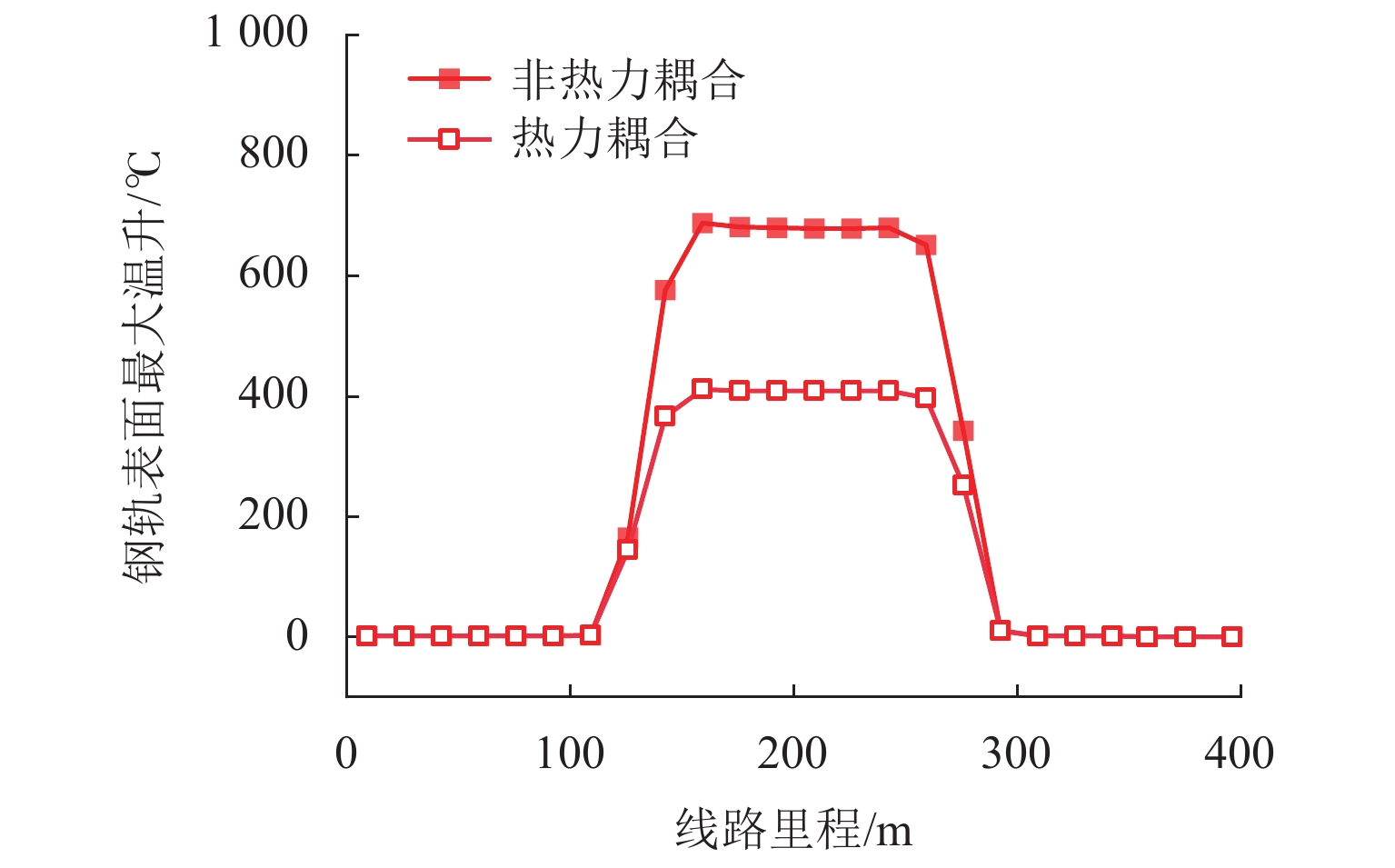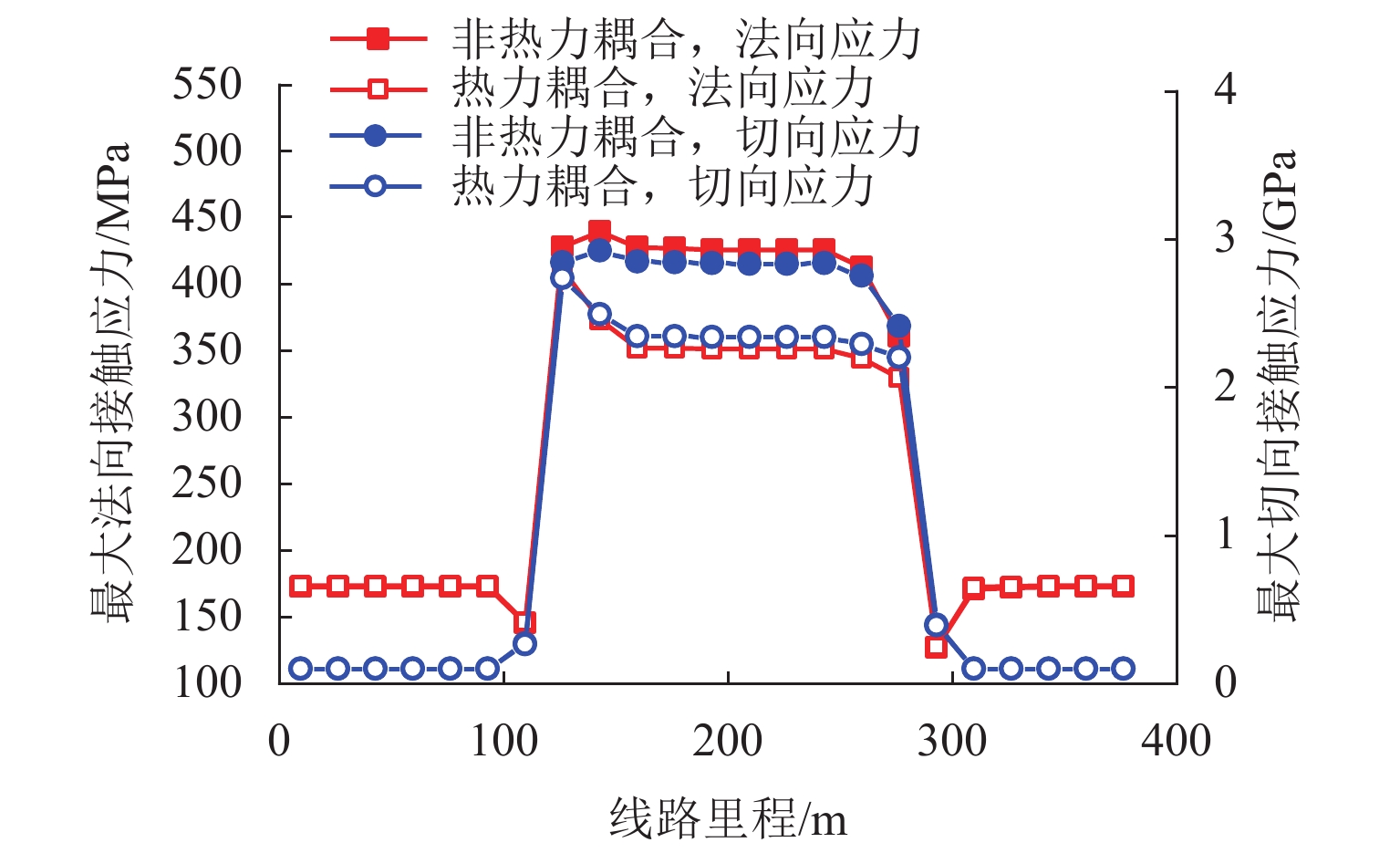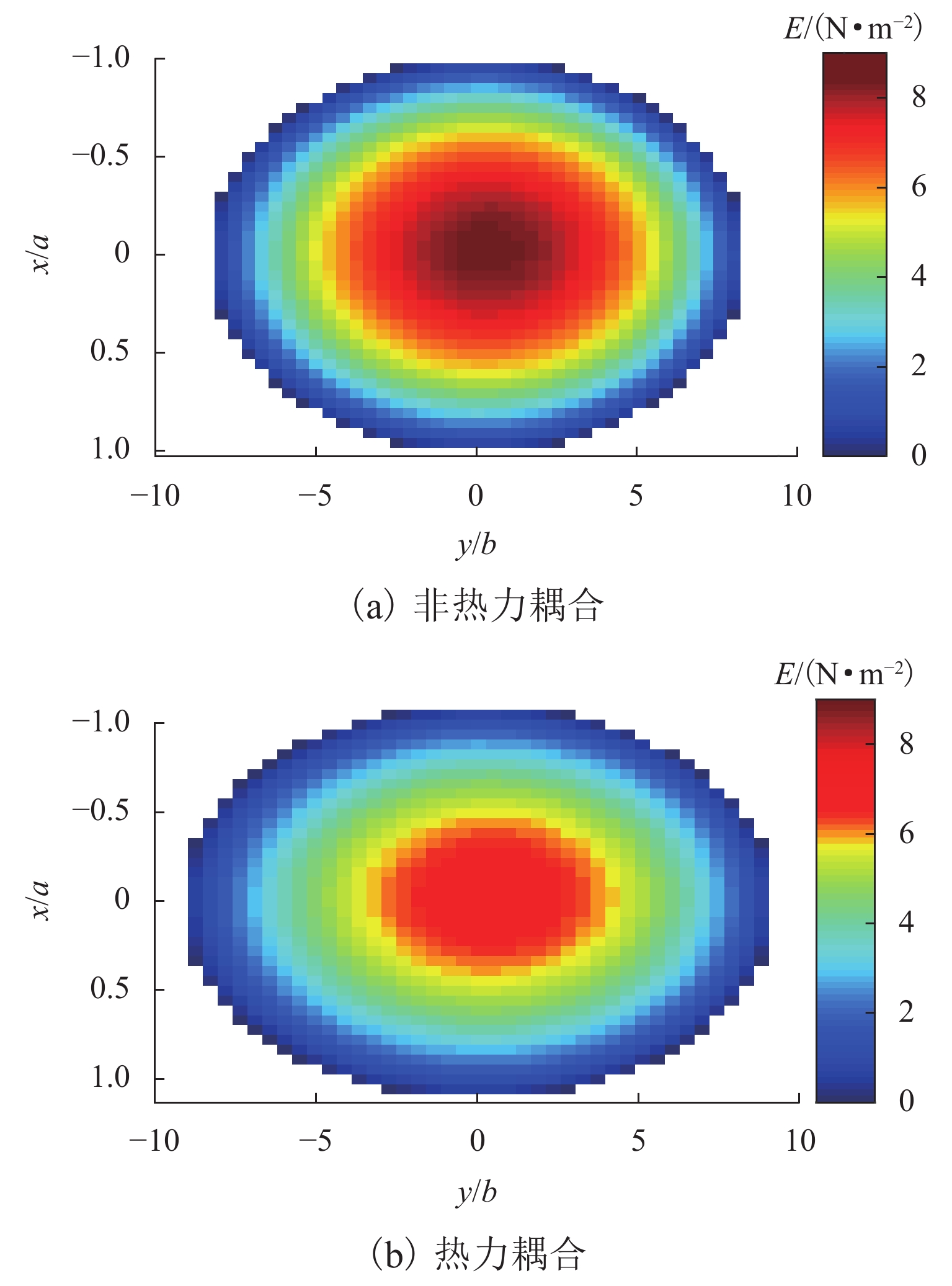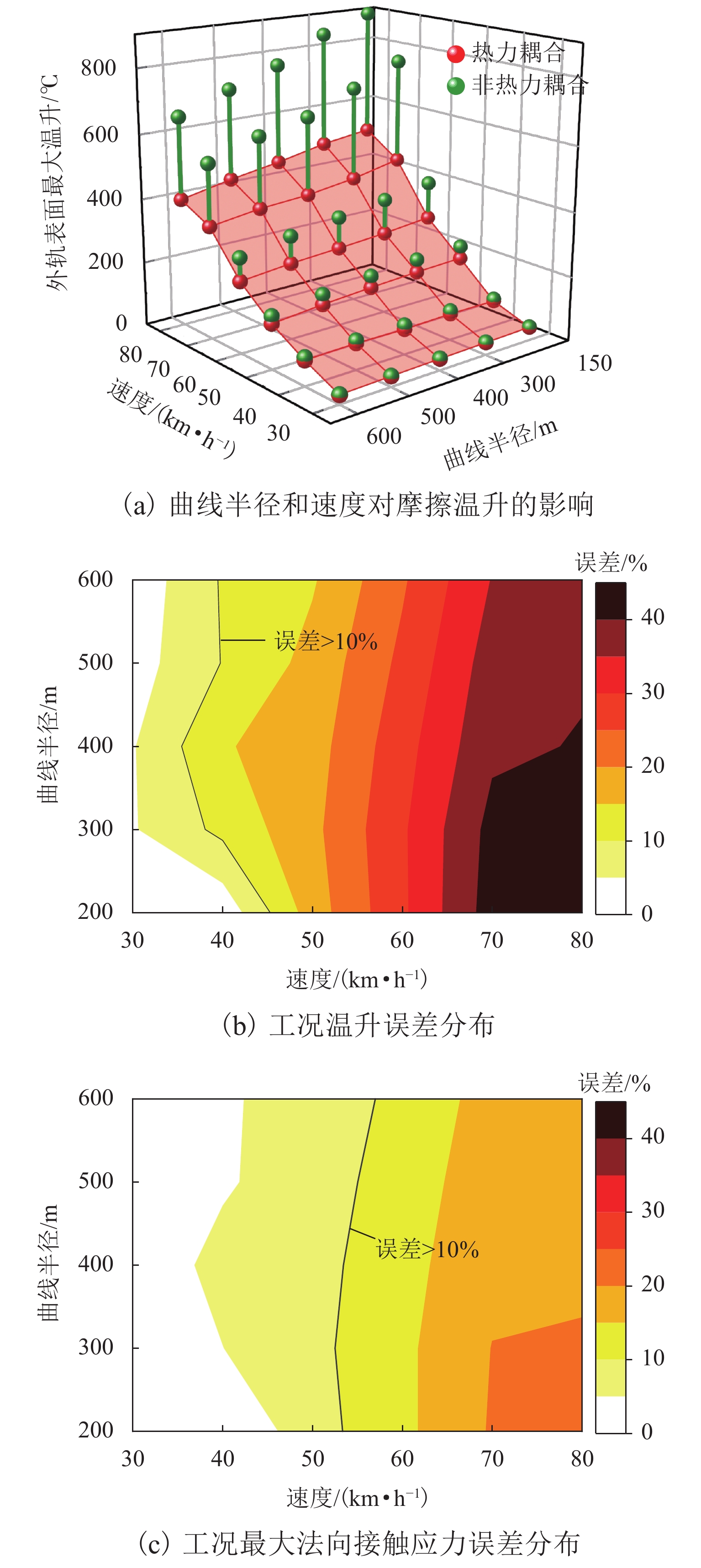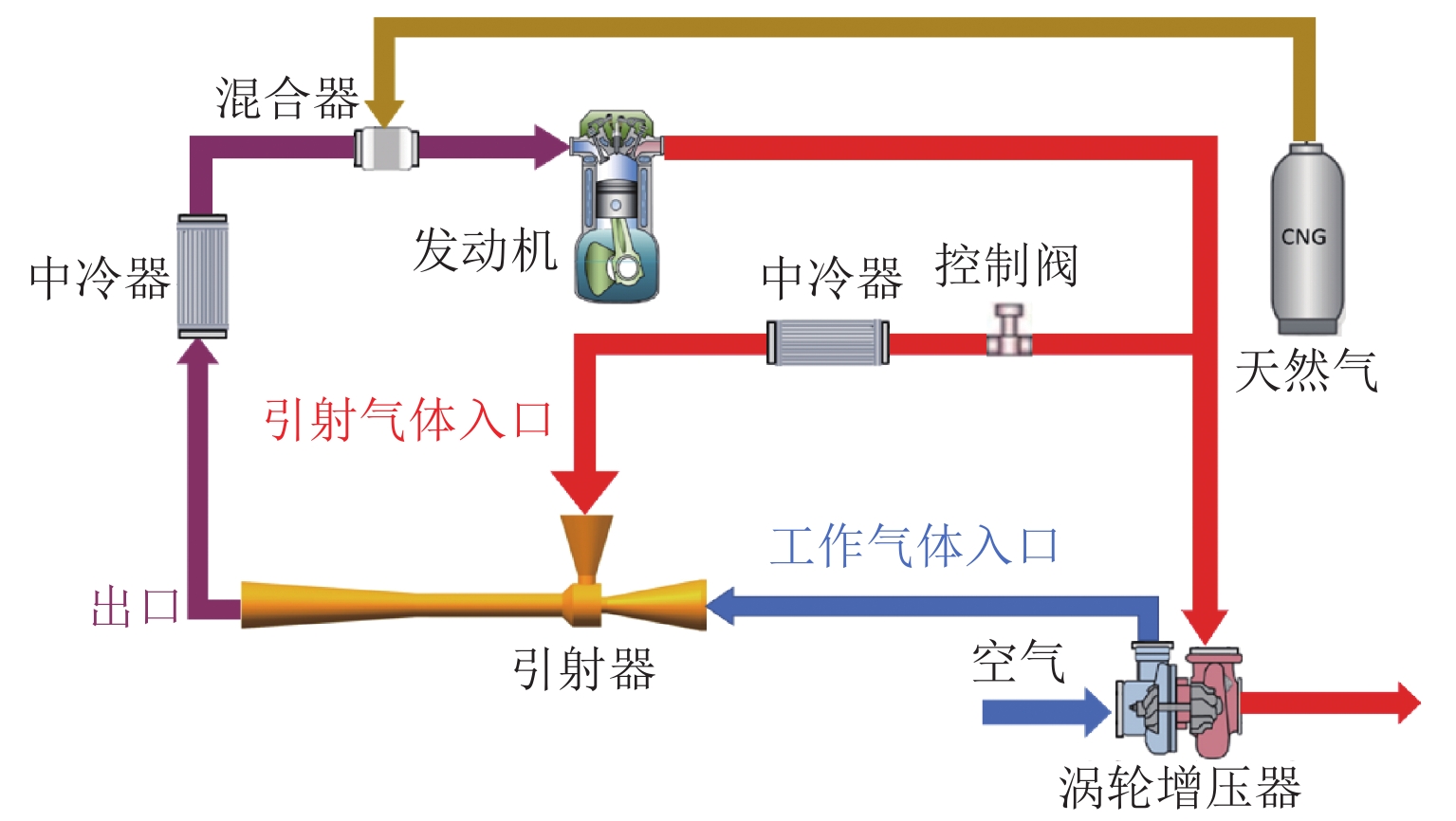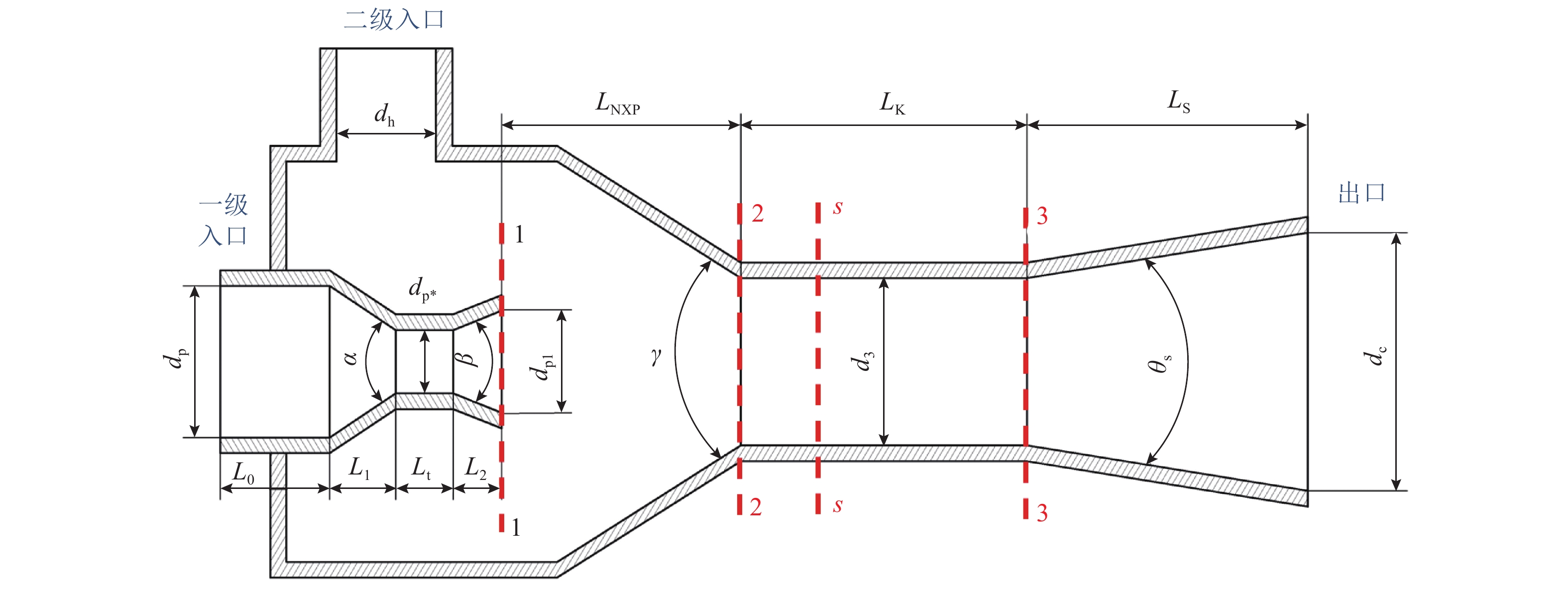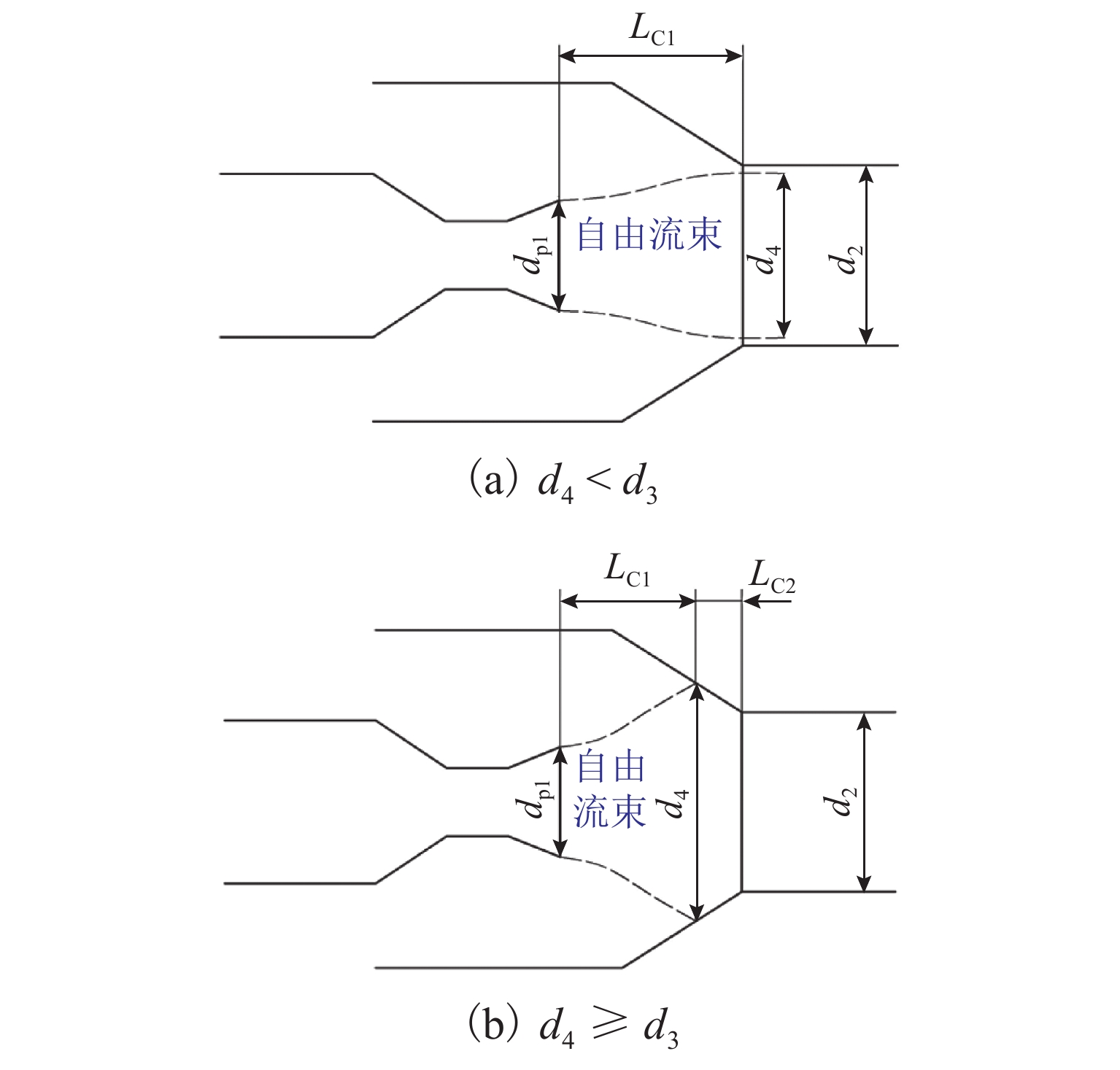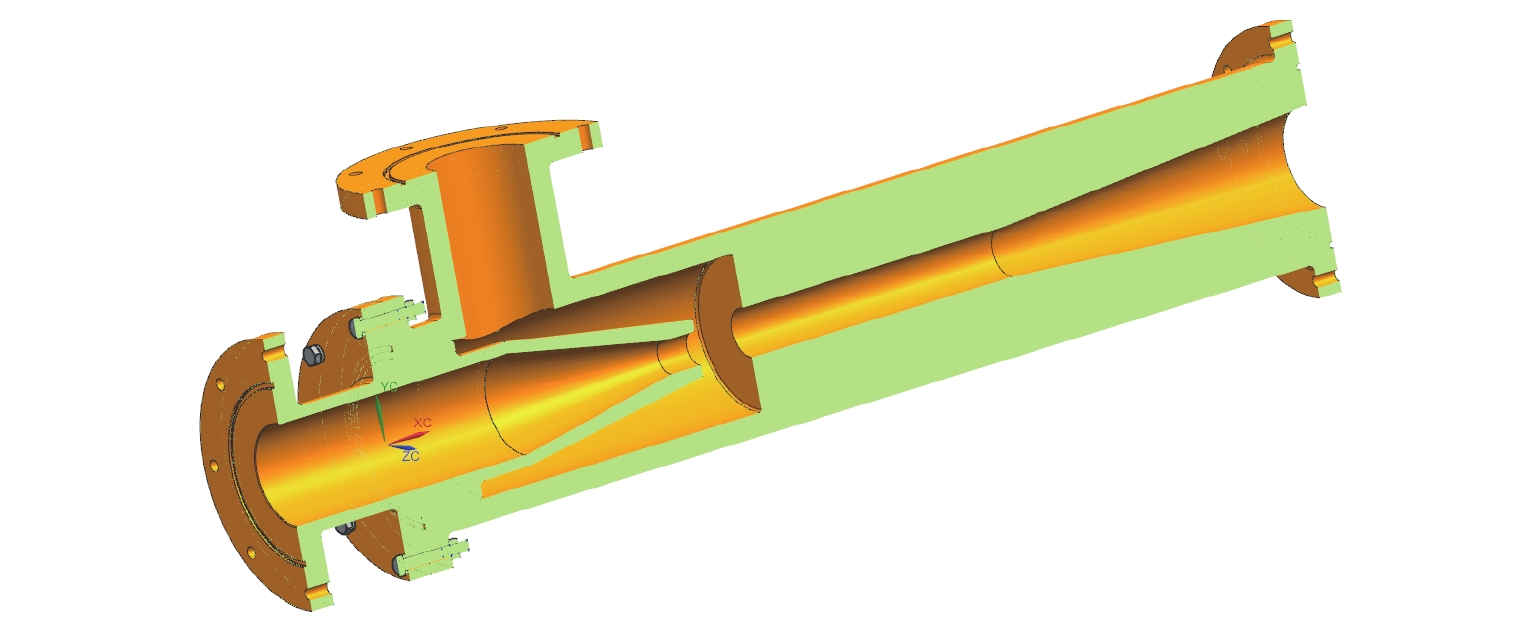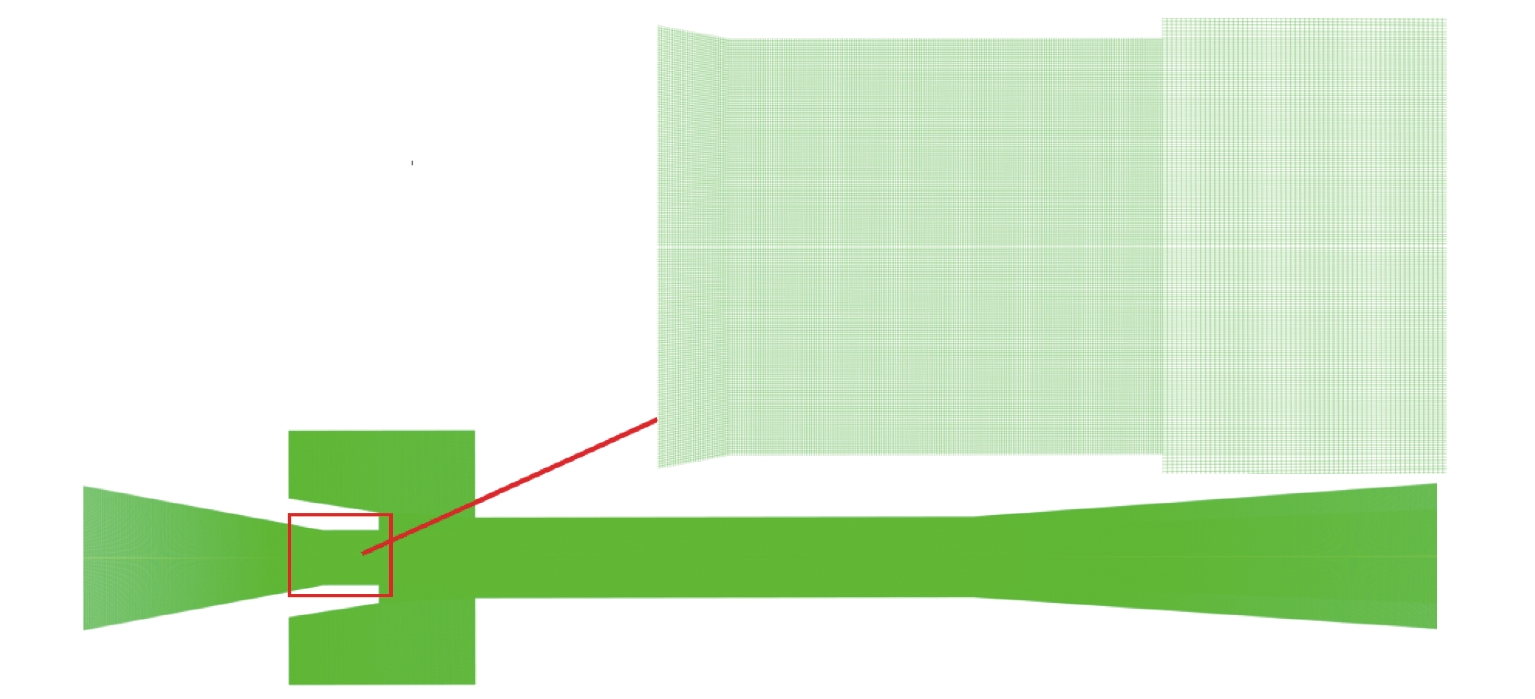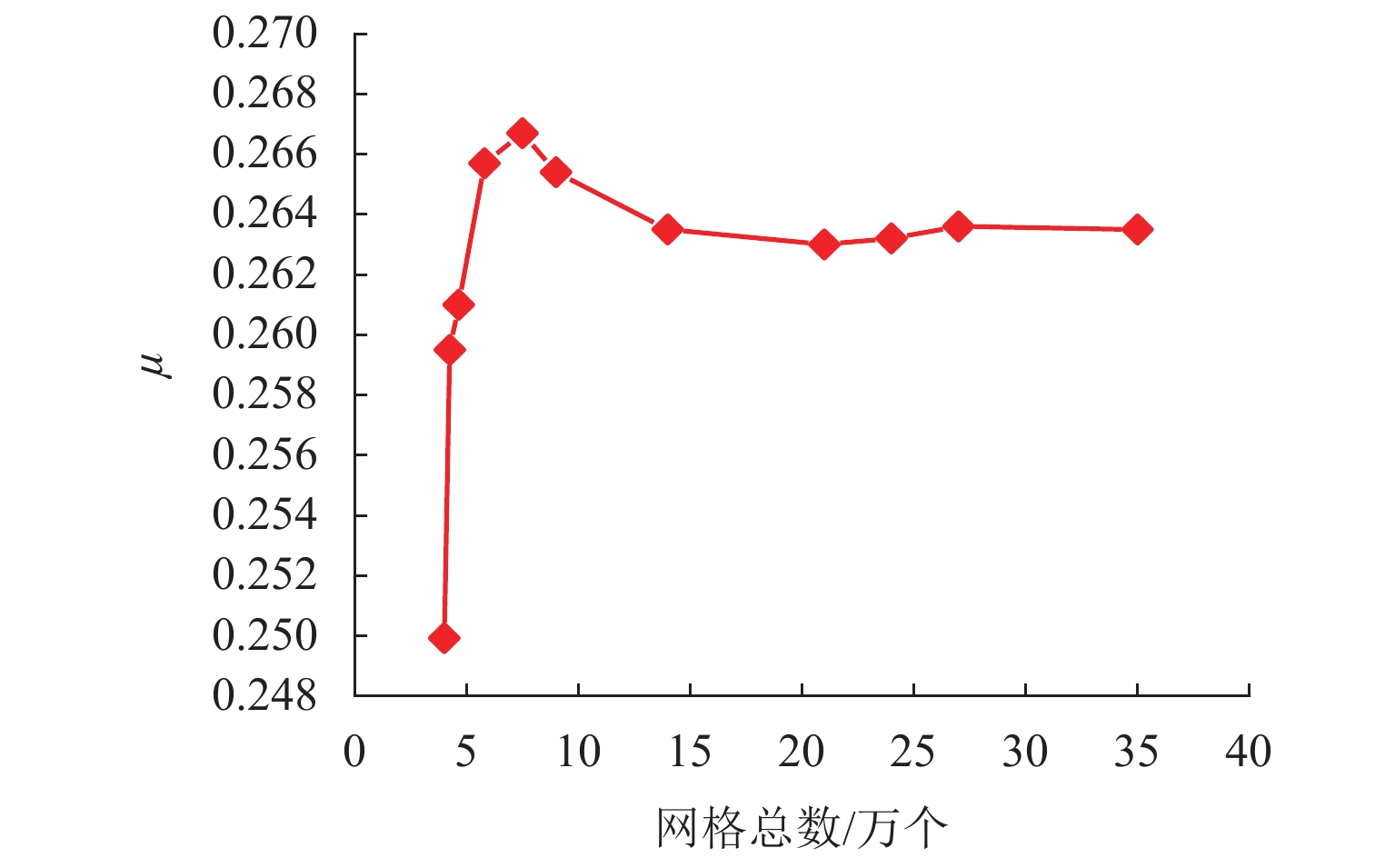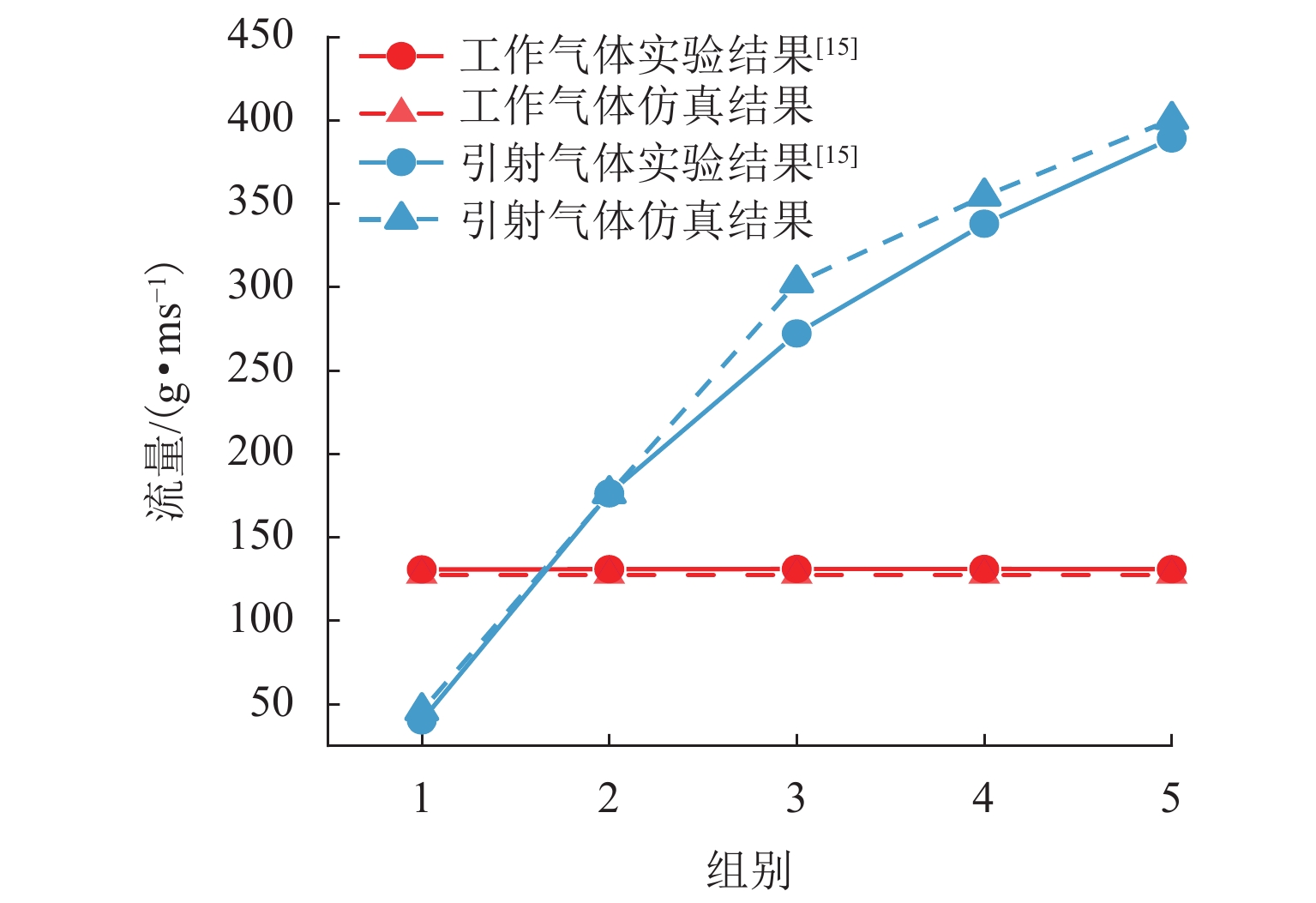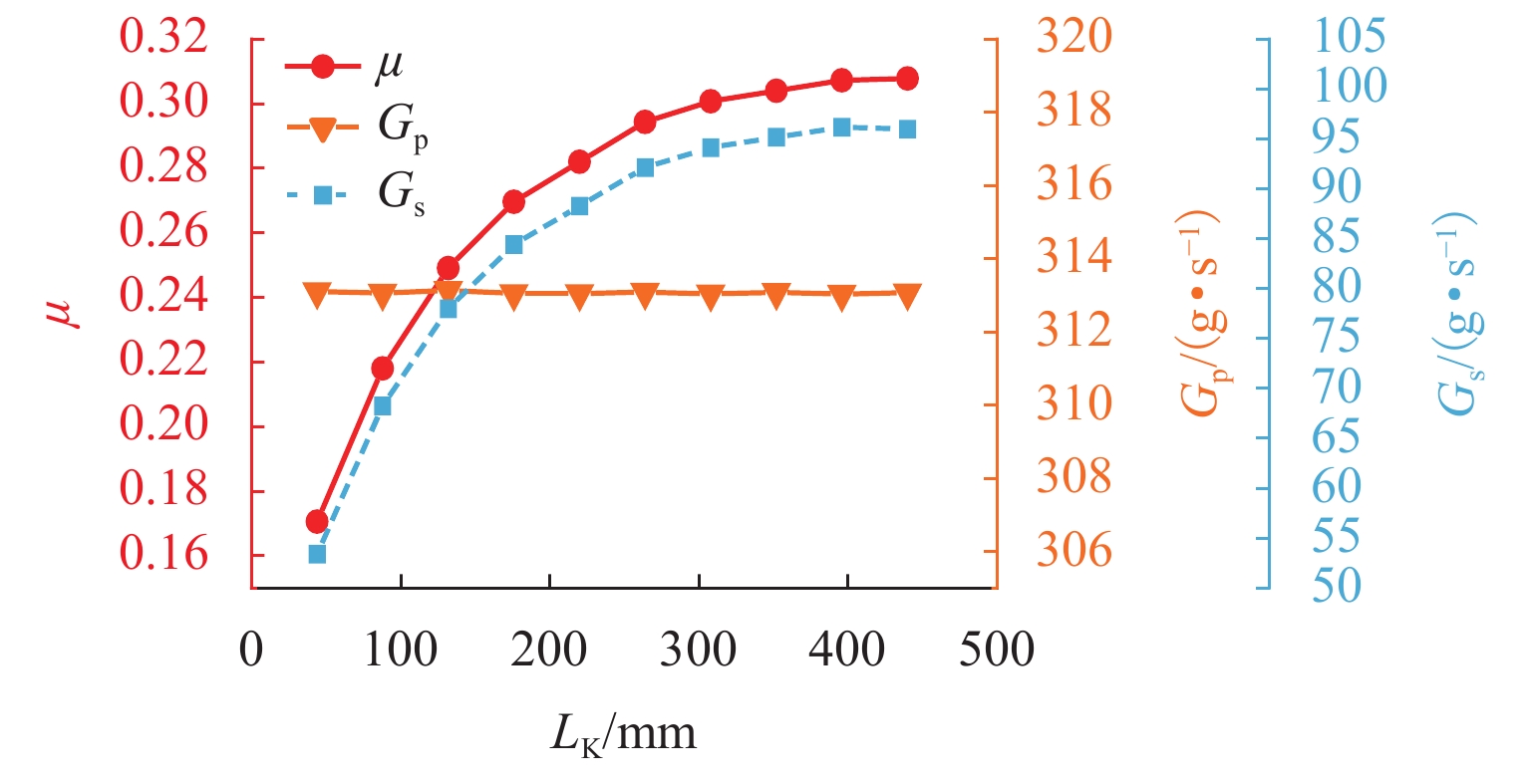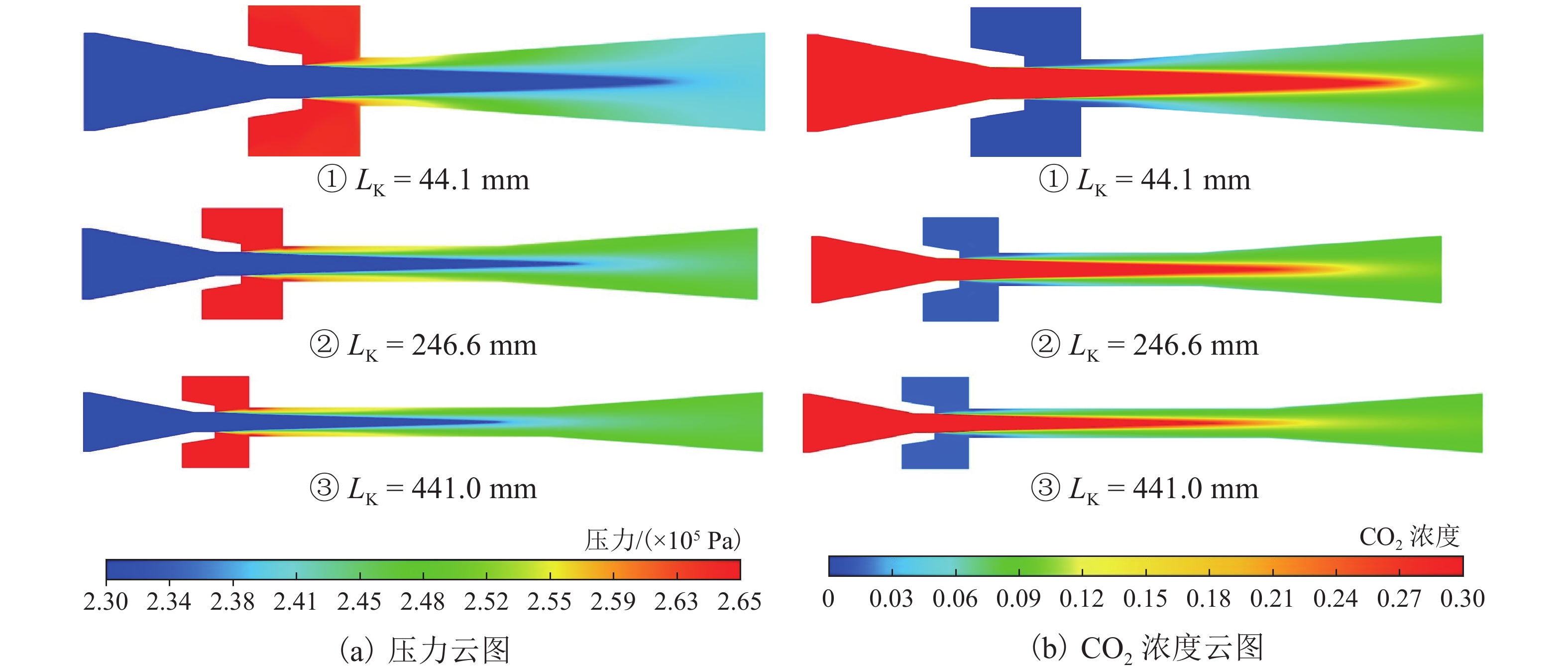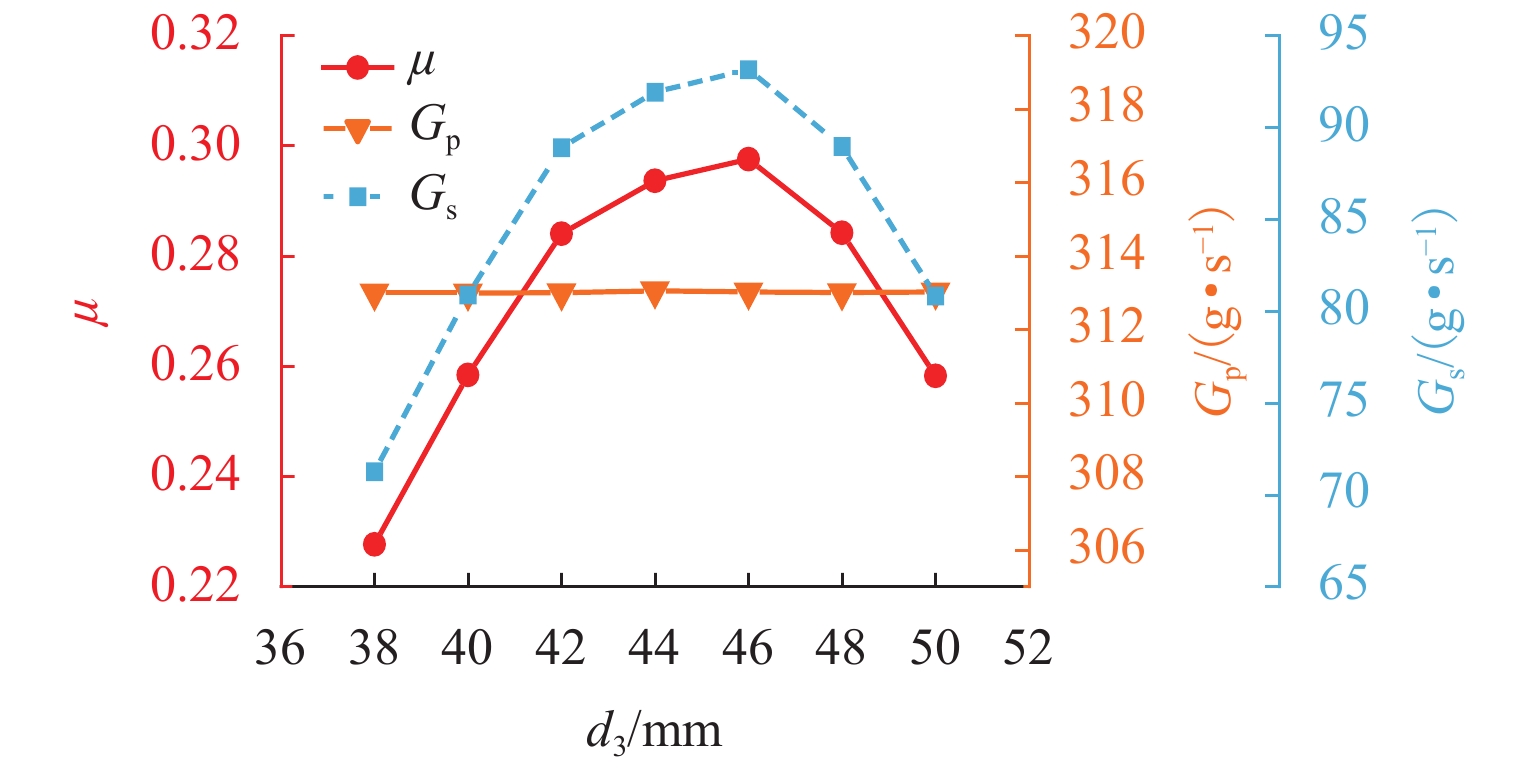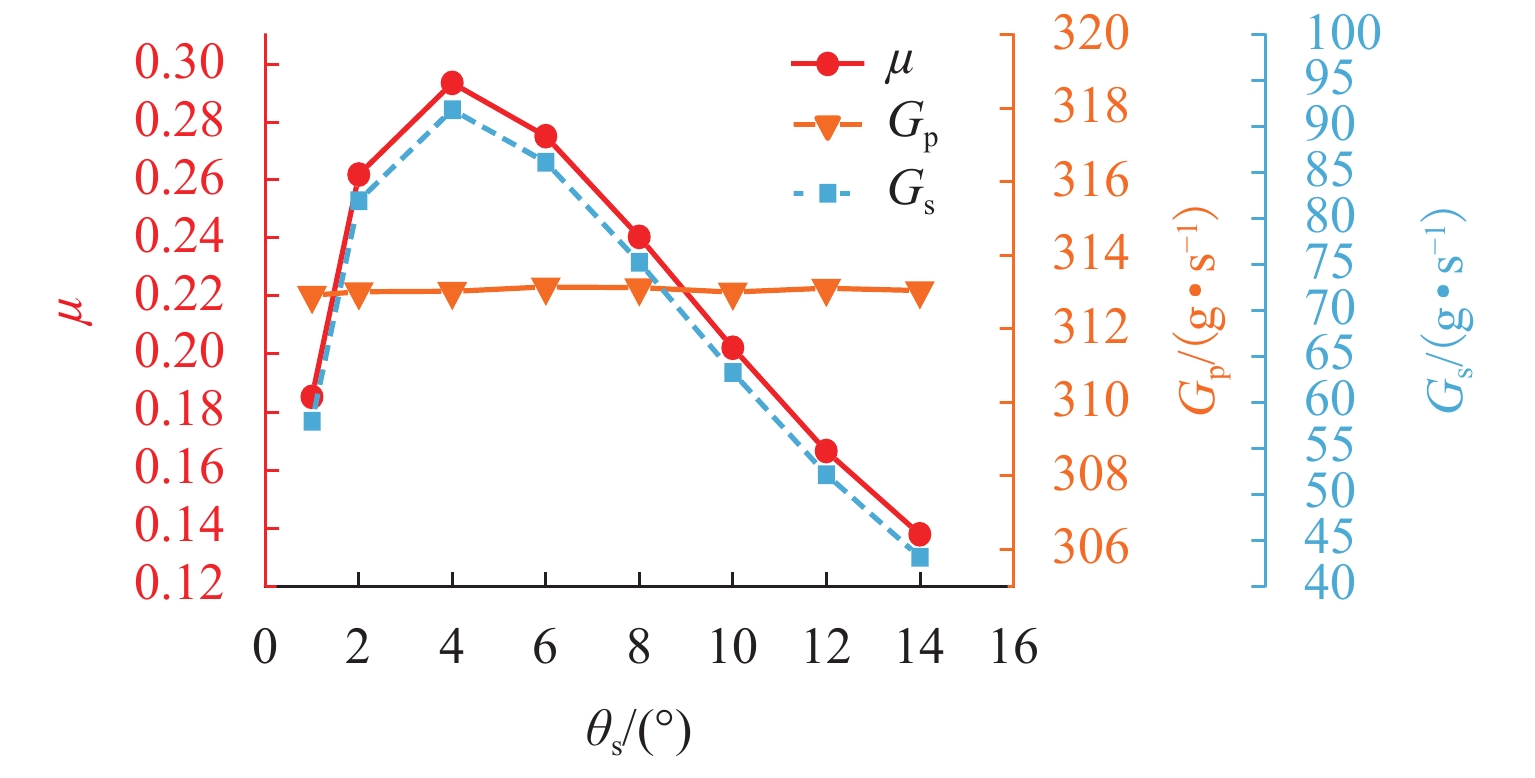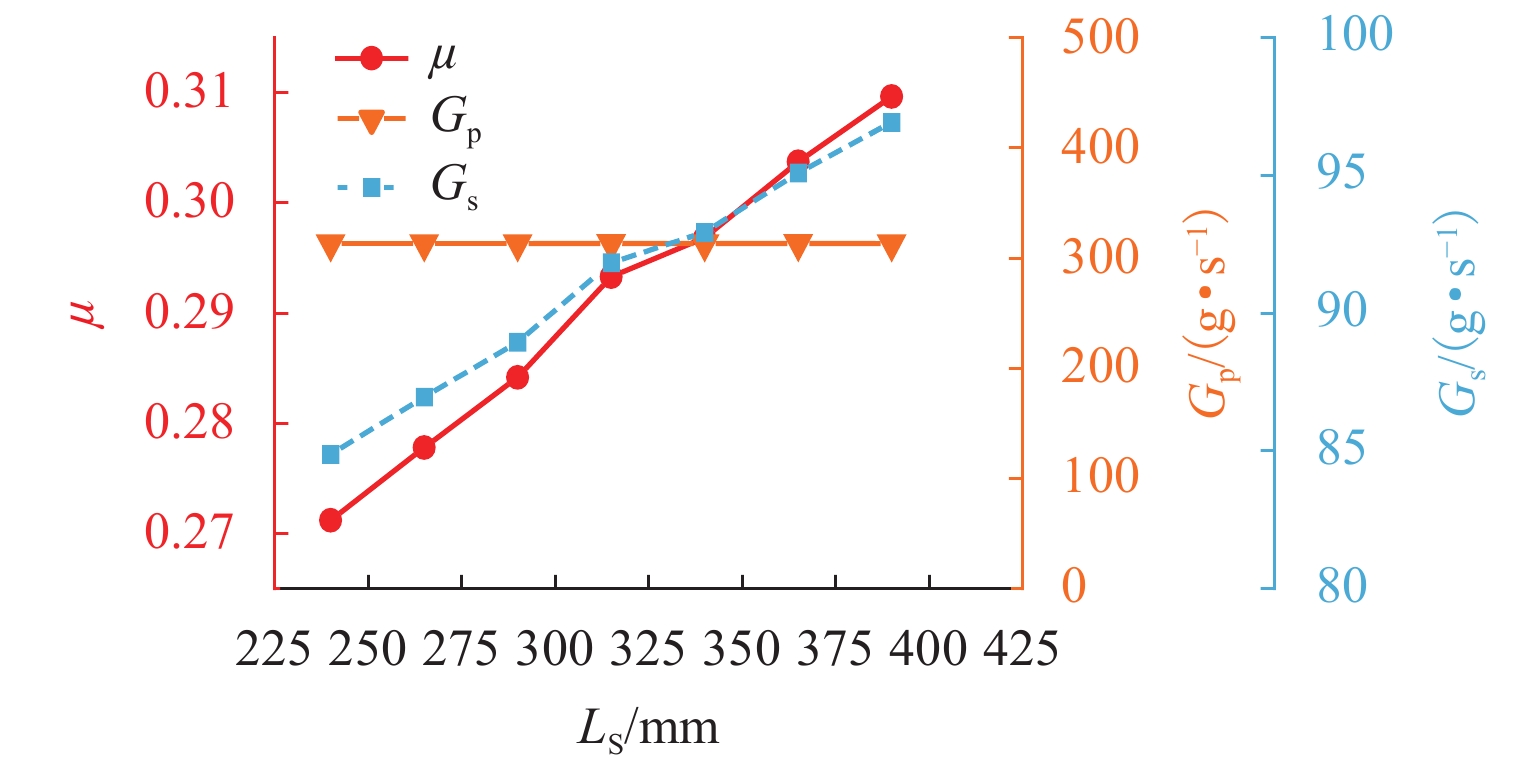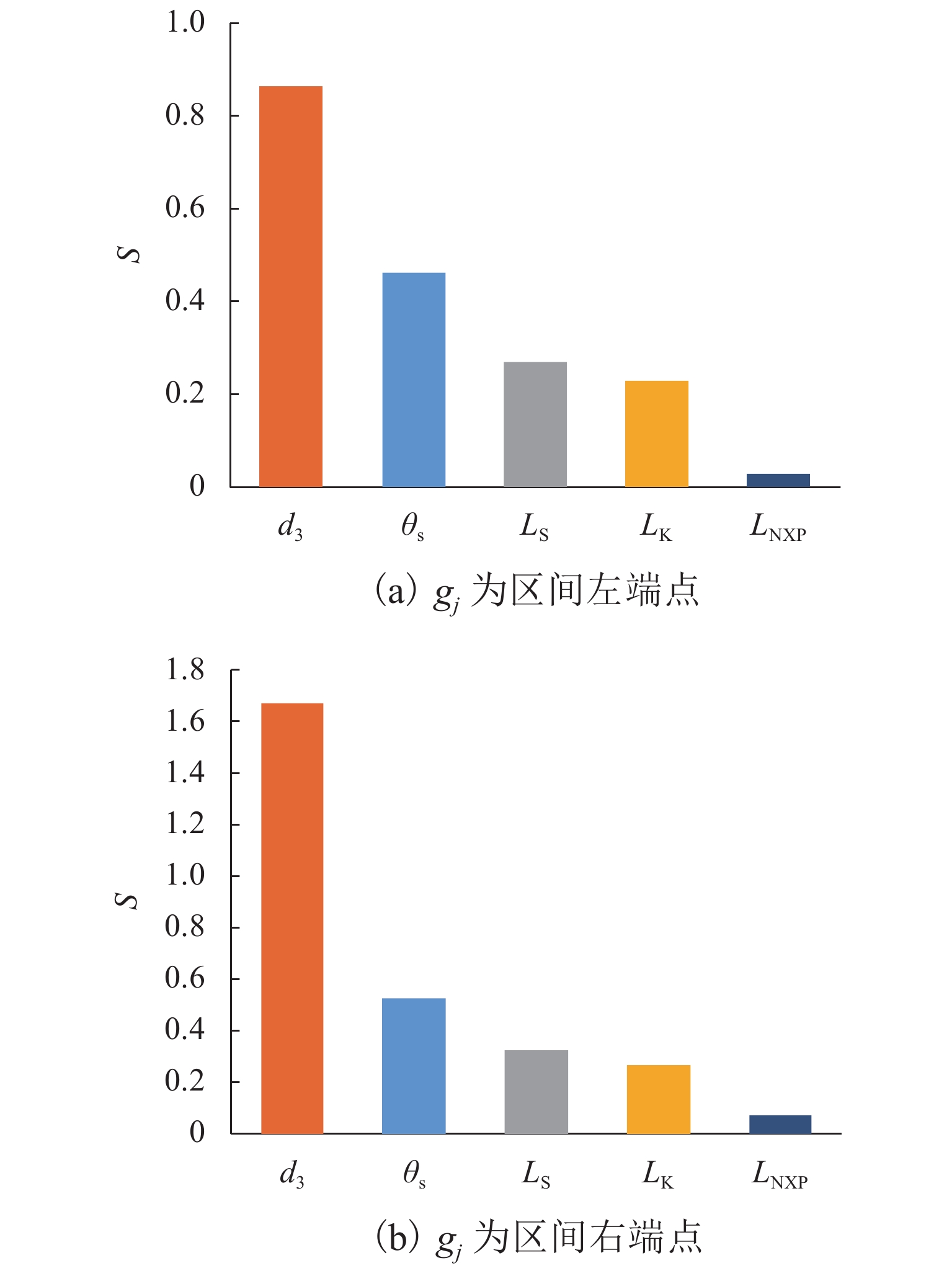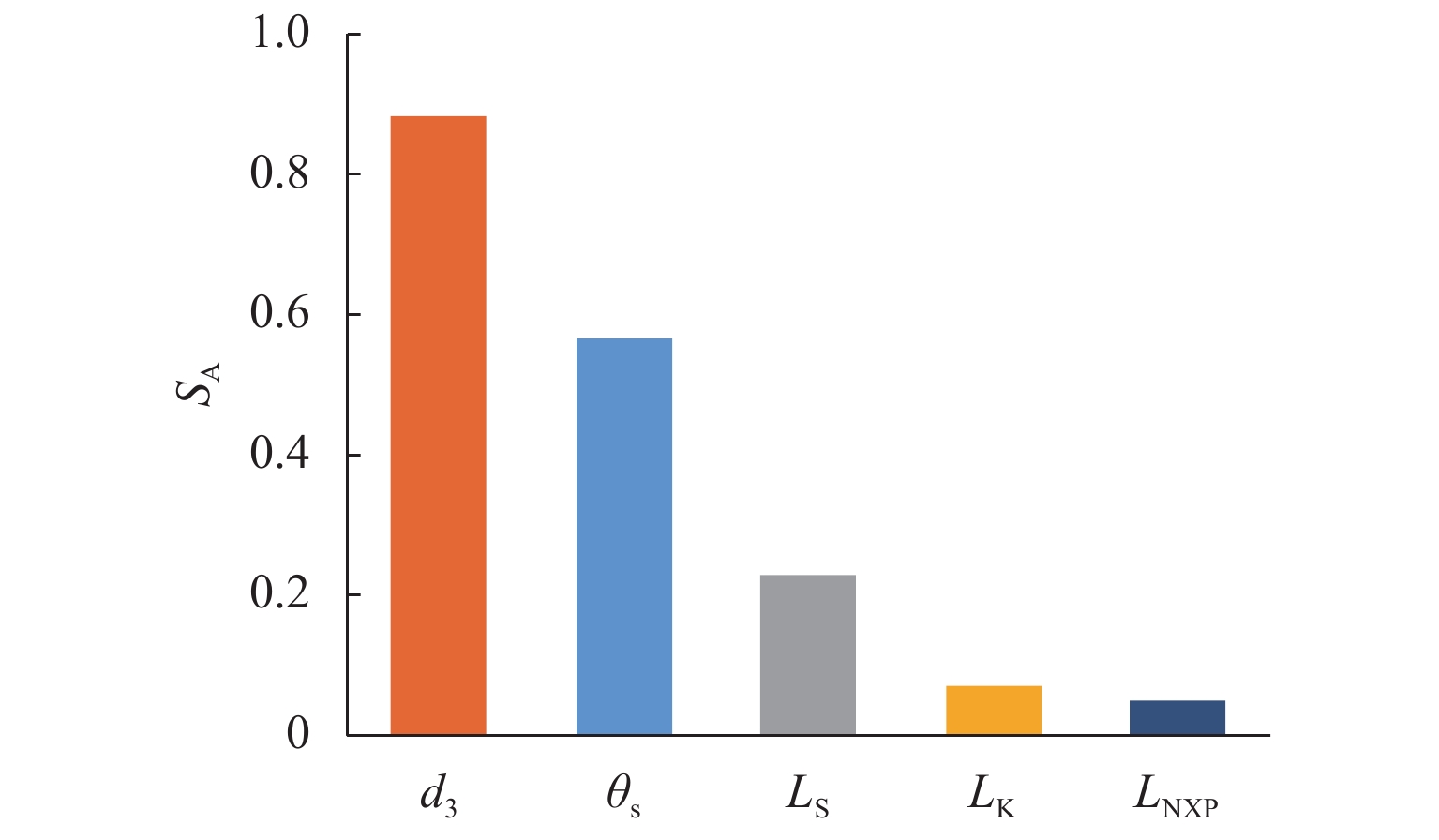Three-Dimensional Wheel–Rail Contact Thermal Analysis Considering Temperature-Dependent Material Property
-
摘要:
为研究材料温变特性对轮轨接触行为和摩擦温升的影响,提出了一种考虑材料温变特性的三维轮轨热力耦合模型,能够考虑纵、横向蠕滑率和自旋的影响,更为真实地模拟轮轨系统的服役状态. 首先,研究了热力耦合建模方式对轮轨界面摩擦温升及接触应力的影响;随后,将该模型应用于地铁小半径曲线处车辆-轨道相互作用模拟. 结果表明:当轮轨界面温度达到450 ℃时,轮轨接触应力显著降低,降幅可达20%;考虑热力耦合建模后,轮轨界面的预测温升明显低于不考虑热力耦合建模时的结果,在蠕滑率为0.16时,两者的差异可达51%;地铁车辆在小半径曲线线路上运行时轮轨摩擦温升因过大的蠕滑率与自旋会急剧增大到750 ℃,应考虑轮轨热力耦合建模以避免过高估计轮轨摩擦温升以及轮轨接触应力.
-
关键词:
- 摩擦温升 /
- 轮轨接触 /
- 热力耦合 /
- 车辆-轨道耦合动力学 /
- 轮轨损伤
Abstract:In order to study the influence of the temperature-dependent material property on the wheel–rail contact behavior and frictional temperature rise, a three-dimensional wheel–rail thermal-mechanical coupling model considering the temperature-dependent material property was proposed in this paper, which could consider the longitudinal and lateral creepage rates and spins to simulate the service state of the wheel–rail system more realistically. In this paper, the influence of the thermal-mechanical coupling modeling method on the wheel–rail frictional temperature rise and contact stress was first studied. Subsequently, this model was applied to the simulation of vehicle–rail interaction of subways running on a small radius curve. The results show that when the temperature reaches 450 ℃, the wheel–rail contact stress is significantly reduced by 20%. After considering the thermal-mechanical coupling modeling, the predicted temperature rise of wheel–rail interface is significantly lower than that without considering the thermal-mechanical coupling modeling. When the creepage rate is 0.16, the difference between the two can reach 51%. Due to excessive creepage rate and spin, the wheel–rail frictional temperature rise will increase sharply to 750 ℃ when subways run on a small radius curve. Therefore, the wheel–rail thermal-mechanical coupling modeling should be considered to avoid overestimating the wheel–rail frictional temperature rise and wheel–rail contact stress.
-
随着化石资源的枯竭和环境污染的严重,人们对以燃油为燃料的发动机的经济性和排放性提出了越来越高的要求,促使内燃机科研人员积极开展清洁低碳/无碳燃料发动机的研究. 和其他代用燃料相比,天然气辛烷值高,发动机可以采用涡轮增压和高压缩比,从而实现和传统发动机相近的功率和效率,天然气发动机得到了广泛的发展和应用. 然而,天然气发动机在大负荷下容易出现爆震现象,虽然通过废气再循环(EGR)可以抑制大负荷下的爆震,但是,EGR的提高会降低涡轮增压效率,造成“鱼与熊掌无法兼得”. 针对天然气发动机大负荷爆震这一技术难题,本文提出了采用引射器进行废气引射的技术方案,可以实现在不影响涡轮增压下提高天然气发动机的EGR率[1]. 在该技术方案中,满足发动机EGR率的引射器正向设计和研究是难点.
张心悦等[2]开展了不同边界条件下喷嘴出口至混合段距离(LNXP)对引射器性能影响的仿真研究,确定了适用于燃料电池工况的LNXP最优值. Zhang等[3]采用仿真和实验手段研究了主喷嘴的尺寸及位置对R236fa工质引射器性能的影响,确定了该引射器的最优LNXP值和接收段角度. Zhu等[4]研究发现,LNXP和接收段角度对引射器引射性能影响较大,接收段角度影响程度更明显. 于文艳等[5]研究了不同结构参数下蒸气引射器引射系数的变化规律指出,随着混合段长度的增加,引射系数先增加而后减小,存在一个最大的引射系数. Mazzelli等[6]着重开展了超音速空气引射器的仿真研究,基于实验数据完成了二维/三维仿真模型的校核验证工作,同时指出湍流模型对准确模拟引射器内部流动的重要性.
大部分的研究工作是针对制冷和蒸汽系统用的超临界引射器开展的,较少涉及引射器的正向设计方法,尤其是针对天然气发动机高EGR率用的引射器设计. 因此,本文首先开展基于压力边界的引射器正向设计方法研究;之后,以潍柴动力WP13天然气发动机大负荷下EGR率需求为设计指标,开展引射器主要结构参数设计,采用流体动力学方法进行结构参数对引射器引射系数影响规律的仿真研究,提出引射器引射系数敏感性评价指标,确定了各结构参数对引射系数的影响程度.
1. 天然气发动机高EGR率技术方案
潍柴开发并量产的WP13火花塞点火式天然气发动机采用了S-POWER智能控制技术,其销量一直居于国内领先地位. 在1100 r/min低速大扭矩工况下,WP13天然气发动机涡轮前废气排压为268.6 kPa,进气中冷前气压为266.1 kPa,在如此小的压差下,WP13发动机很难利用压差通过EGR阀把废气直接引入到气缸内.
因此,针对WP13低速大负荷这一特殊工况,本文提出采用引射器实现在不影响涡轮增压效果下使进入发动机气缸内废气量增加. 图1为适用于WP13天然气发动机高EGR率的引射器布置方案. 经过压气机增压后的新鲜空气是工作气体,工作气体通过引射器工作气体入口进入到引射器内,经过中冷器涡轮前的高压废气是引射气体,通过引射器引射气体入口进入到引射器内,引射器出口和发动机进气管连通.
2. 引射器主要结构参数正向设计
图2为引射器的一般结构示意,由喷嘴和引射器体组成. 根据工作用途,在喷嘴和引射器体之间形成的腔体分为接受段、混合段和扩压段,图中各符号的含义如表1所示. 引射器结构较为简单,但实际上,在引射器内部2种气体的混合过程异常复杂,关键结构参数较小的变化会直接影响引射器的引射性能. 引射系数μ通常作为引射器的性能评价系数,定义为引射器引射气体流量Gs与工作气体流量Gp的比值.
表 1 引射器结构示意图符号含义Table 1. Symbolic meaning of ejector structure变量 含义 dp/mm 喷嘴入口直径 dp*/mm 喷嘴临界直径 dp1/mm 喷嘴出口直径 dh/mm 引射气体入口直径 d3/mm 混合段直径 dc/mm 扩压段出口直径 L0/mm 喷嘴入口段长度 L1/mm 喷嘴收缩段长度 Lt/mm 喷嘴喉部长度 L2/mm 喷嘴扩张段长度 LK/mm 混合段长度 LS/mm 扩压段长度 α/(°) 喷嘴收缩角 β/(°) 喷嘴扩散角 γ/(°) 接收段夹角 θs/(°) 扩压段扩散角 在已知的引射器研究工作中,大部分工作是直接用现有的引射器开展仿真或实验,并不提及引射器的设计;一部分工作开展引射器的设计研究,但设计的前提需要假设引射器为双雍塞式,即工作气体在喷嘴喉部发生雍塞,引射气体在混合段截面上发生雍塞. 在引射器设计过程中,引射器为超临界或亚临界取决于引射器的压力边界条件,上述的假设使得已有的正向设计方法存在一定的不足,亟需开展引射器主要结构参数正向设计方法研究.
2.1 引射器喷嘴参数设计
引射器工作在亚临界状态还是超临界状态决定引射器的喷嘴形式. 引射器工作状态需要通过工作气体临界压力Pp* (式(1))与引射器气体压力Ps之间关系判断.
Pp*=Ps(2χ+1)χχ−1, (1) 式中:χ为工作气体的绝热系数.
当工作气体在喷嘴出口处压力Pp1与引射气体压力Ps相等时,可以实现最好的引射效果. 在工作气体从喷嘴喷出时,如果压力仍然大于引射气体压力,工作气体会继续膨胀,在管内占用的流道面积增大,挤占引射气体的流道面积,导致引射气体流通损失增加,使得引射器引射效果变差.
随着工作气体从滞止状态开始降压加速,如果喉部位置的Pp* 仍然大于Ps,那么工作气体需要继续降压加速,使其进入超临界状态,此时实现Pp1=Ps. 在工作气体从滞止状态降压加速时,当流道面积大于计算出的最小喉部面积时,Pp1已经等于Ps,那么,降压加速过程在亚临界状态实现. 因此,当Pp*>Ps时,喷嘴为拉伐尔式喷嘴;当Pp*≤Ps时,喷嘴为渐缩式喷嘴.
1) 喷嘴入口直径
喷嘴入口直径dp计算式为
dp=√4fpπ=√4GpRTpπwpPp, (2) 式中:fp为喷嘴入口面积,Tp为工作气体温度,Pp为工作气体压力,wp为上游气体流速,R为气体常数.
2) 喷嘴临界直径dp*
对于超临界或亚临界喷嘴,引射器喷嘴喉部横截面积fp* 通过式(3)确定.
fp*=Gpap*χΠp*Pp, (3) 式中:ap* 为临界声速,如式(4);Πp* 为临界相对压力,如式(5).
ap*=√2χRTχ+1, (4) 式中:T为温度.
Πp*=(2χ+1)χχ−1. (5) 根据临界压力理论,喷嘴的临界直径dp*为
dp*=√4Gpap*πχΠp*Pp. (6) 3) 喷嘴出口直径dp1
喷嘴出口处工作气体相对压力Πp1为
Πp1 = Pp1Pp = PhPp, (7) 式中:Ph为引射气体压力.
根据气体动力学可知,喷嘴出口处工作气体相对速度为
λp1=√χ+1χ−1(1−Πχ−1χp1). (8) 根据气体流量函数定义,喷嘴出口处工作气体流量函数为
qp1=(χ+12)1χ−1λp1(1−χ−1χ+1λ2p1)1χ−1. (9) 通过式(7)~(9)最终确定喷嘴出口直径dp1为
dp1=√4Gpap*πqp1χΠp*Pp. (10) 4) 喷嘴入口段长度L0
在通常情况下,认为喷嘴入口段长度L0与入口直径dp相等,即
L0 = dp. (11) 5) 喷嘴收缩段长度L1
对于拉伐尔式喷嘴,L1需要根据dp、dp*、α(通常α = 22°)确定[7],如式(12).
L1=dp−dp*2tan(α/2). (12) 对于渐缩式喷嘴,L1需要根据dp、dp1、α确定,其公式为
L1=dp−dp12tan(α/2). (13) 6) 喷嘴喉部长度Lt
对于拉伐尔式喷嘴,根据经验公式Lt[8]为
Lt=(1±0.003)dp*. (14) 对于渐缩式喷嘴,将式(14)中的dp* 替换为dp1后即可得到适用于渐缩喷嘴的Lt.
7) 喷嘴喉部扩张段长度L2
对于拉伐尔式喷嘴,L2计算式为
L2=dp1−dp*2tan(β/2). (15) 对于渐缩式喷嘴,因为喷嘴内部没有扩张段,故L2 = 0.
8) 混合段和扩压段结构参数
根据气体动力学,引射器混合段出口直径d3计算式为
d3=√4Gpap*(1+μmax√THTp)πχPcqc3(2χ+1)χχ−1, (16) 式中:μmax为最大引射系数,qc3为混合段出口截面流量,TH为引射气体温度,Pc为混合气体出口压力.
引射器的扩压段出口直径d3根据式(17)确定[9].
d3=dc/√c, (17) 式中:c为待定系数,通常在4~9内取值.
在已知d3后,根据经验公式得到混合段长度LK[10]为
LK=nd3, (18) 式中:n为待定系数,通常在6~10内取值.
扩压段长度LS由d3、dc和θs(取值范围为5°~10°)共同确定,LS计算式为
LS=dc−d32tan(θs/2). (19) 9) 喷嘴出口处到混合段距离
图3所示为引射器喷嘴出口处存在的2种射流状态,图中:LC1为自由流束轴向长度,LC2为自由流束末端到混合段入口处的距离,d4为自由流束的假设直径,d2为混合段的入口直径. 其中,d4和d2存在图3所示的2种情况.
1) d4确定
d4的计算公式取决于引射器最大引射系数μmax的范围,其计算式为
d4={3.4dp1√0.083+0.76μmax,μmax<0.5,1.55dp1(1+μmax),μmax⩾0.5. (20) 2) LC1确定
μmax同样决定LC1,LC1由式(21)确定.
LC1={dp12a(√0.083+0.76μmax−0.29),μmax<0.5,0.37+μmax4.4adp1,μmax⩾0.5, (21) 式中:a为待定系数,由式(22)计算得到.
a={0.07,μmax<0.2,0.09,μmax⩾0.2. (22) 3) LC2确定
在d4>d3情况下,LC2按照图3(b)进行计算,如式(23).
LC2=d4−d32tanγ2. (23) 4) LNXP确定
根据确定的d4与d3的关系,喷嘴出口至混合段距离为
LNXP={LC1,d4<d3,LC1 + LC2,d4⩾d3. (24) 最终,本文提出了任意类型引射器的正向设计方法和相应计算公式. 根据本文提出的设计方法,在满足WP13天然气发动机在1100 r/min工况下EGR提高到20%设计指标,正向设计得到了适用于天然气发动机高EGR率的引射器三维模型,如图4所示.
3. 引射器数学模型介绍及校核
3.1 湍流模型
在引射器内部,工作气体和引射气体的混合和射流过程具有强湍流特性,因此,湍流模型对引射器引射过程的精确预测具有重要的影响.
Bartosiewicz等[11-12]开展了不同湍流模型对引射器引射过程影响的研究,和renormalization group (RNG) k-ε(k为湍动能,ε为耗散率)和realizable k-ε模型相比,shear stress transport (SST)k-ω(ω为比耗散率) 模型可以更加准确地预测引射器内部气体的混合,特别是激波现象. 在SST k-ω模型输运方程中,由于加入了k和ω 2项,所以SST k-ω在预测自由剪切流方面具有更高的准确性.
SST k-ω的输运方程为
∂∂t(ρk)+∂∂xi(ρkui)=∂∂xj(Γk∂k∂xj)+Gk−Yk+Sk+Gb, (25) ∂∂t(ρω)+∂∂xi(ρωuj)=∂∂xj(Γω∂ω∂xj)+Gω−Yω+Sω+Gωb, (26) 式中:xi为水平方向分量;xj为竖直方向分量;ρ为密度;t为时间;ui为水平方向的速度;uj为竖直方向的速度;Γk和Γω分别为k和ω的有效扩散率;Yk和Yω分别为由于湍流引起的k和ω的耗散;Sk和Sω为源项;Gb和Gωb为浮力对湍流的影响程度;Gk为平均速度梯度产生的湍动能,如式(27);Gω为ω的产生项,如式(28).
Gk=−ρ¯ui′uj′∂uj∂xi. (27) Gω=zωkGk, (28) 式中:z为系数,由式(29)确定[13].
z=α∞α∗(α0+Re/Rω1+Re/Rω), (29) 式中:α∗为表征湍流黏度阻尼效应的系数;α0为流体处于低雷诺数时的矫正系数;Rω为系数,通常取2.95;α∞为常数项系数,通常取0.52.
3.2 收敛准则
在数值模拟过程中,基于残差的均方根定义收敛标准,如式(30).
R=√∑ni=1∂Yi∂Xi, (30) 式中:n为网格数,Yi为网格i的目标变量,Xi为网格i的独立变量.
在进行三维数值仿真时,所有残差满足预期精度并保持恒定后才能说明仿真满足设定的收敛准则. 而且,需要检查净质量通量是否符合预期限制. 对于相对质量平衡Qnet,该值通常设置在10−5之内,由式(31)确定[14]. 在进行仿真收敛准则设定时,所有变量的残差值均设置为10−5.
Qnet=∑qmot+∑qsuc∑qdis, (31) 式中:qmot为工作流体局部质量流量,qsuc为引射流体局部质量流量,qdis为出口流体局部质量流量.
3.3 模型的校核与验证
在采用有限元法进行数值计算时,计算结果的准确性随着网格数量的增加而增大,但同时计算的时间也会大幅度增加,因此,需要在计算精度和计算时间兼顾的情况下进行网格无关性研究.
本文采用ANSYS Meshing进行引射器网格划分,在进行划分时,整体上采用结构化网格进行网格划分,同时,在喷嘴喉部和存在高流速的区域进行网格加密,以实现在该区域流动的准确计算. 图5为得到的二维引射器结构化网格.
图6为不同网格数下引射系数的变化. 从图6看到:在引射器网格数从1.7万增加到35万过程中,μ从0.250增加到最大值0.267,之后开始下降;在网格数大于20万后,网格的增加对μ不产生影响,μ维持在0.264左右. 在综合考虑计算时间和计算精度条件下,本文确定了可以准确描述引射器引射过程的引射器网格数为20万,最小网格尺寸约为0.07 mm.
为验证本文仿真数学模型和参数选择的合理性,采用Nikiforow等[15]实验数据进行模型的校核验证. 表2列举了Nikiforow进行的部分实验工况和流量实验数据.
表 2 Nikiforow的引射器实验数据Table 2. Experimental data of Nikiforow’s ejector组别 Pp/MPa Ps/MPa Gp/(g·ms−1) Gs/(g·ms−1) 1 2.00 0.0851 130.70 40.2 2 2.00 0.9000 1.75 176.3 3 2.00 0.9500 2.00 272.1 4 2.00 0.0975 2.50 337.9 5 0.20 0.0999 3.01 389.0 图7为在上述5组条件下进行的流量计算结果和实验数据的对比. 从图7看到,工作气体和引射气体流量的计算结果和实验数据具有较好的吻合性,虽然引射气体流量的实验和仿真之间存在一定的误差,但最大误差不超过10%,满足工程研究误差要求. 引射器流量计算结果和实验数据的吻合性证明了本文构建的引射器模型可以准确模拟引射器的工作过程.
4. 结果和讨论
4.1 结构参数对引射系数的影响
在本文中,基于第3节确定的网格数量和数学模型,采用三维有限元方法,开展LK、d3、LNXP、θs、Ls 5个参数对引射器引射系数影响规律的仿真研究,其变化范围如表3.
表 3 几何参数取值范围Table 3. Geometric parameter value range项目 LK/mm d3/mm LNXP/mm θd/(°) LS/mm 基准值 264.6 44.1 57.33 8 315 取值范围 44.1~441.0 38.1~50.1 30.87~83.79 2~14 240~390 图8为LK对引射系数的影响. 从图8看到,随着LK从44.1 mm增加到441.0 mm,μ逐渐增加,并且变化趋于平缓. 原因在于LK的增加不改变Gp,但却使得Gs随之增大,根据引射系数定义可知,在Gp不变的情况下,Gs增加导致μ增大.
图9所示为计算得到的CO2浓度和压力分布云图,从图上更为清楚地看到产生图8所示现象的原因. 由图9可知:当LK从44.1 mm增加到300.0 mm过程中,随着LK的增加,工作气体和引射气体在混合段的压力和CO2浓度的混合变得更加充分,在引射器出口处浓度和压力变得更加均匀,这导致μ随LK的增加而快速增大;当LK>300.0 mm后,随着LK的增加,引射气体压力分布的均匀性的改善较小,这导致LK的继续增加对μ的提高影响不大.
图10 为d3对引射系数的影响. 从图10看到:在d3从38.1 mm增加到50.1 mm的过程中,随d3的增加,Gp几乎不变化,但Gs先增加而后减小,在d3=46.1 mm时Gs达到最大值,这使得μ达到最大;在d3<46.1 mm时,d3的增加导致引射气体流通面积增大,使Gs随之增大;在d3>46.1 mm时,d3的增加使混合容积增大,这减小了出口处气体的流速,从而导致μ的减小;d3对μ的影响主要是d3对工作气体、引射气体混合特性的影响. 需要根据引射器结构进行d3最佳值的确定,以实现引射器最大的引射系数.
图11为LNXP对引射系数的影响. 从图11看到:当LNXP在30.87~57.33 mm内变化时,随着LNXP的增加,引射气体在进入混合段前获得越来越充分的加速,使引射气体具有更高的动能,导致Gs随之增大,从而μ随LNXP的增加而增大;当LNXP> 57.33 mm后,当LNXP继续增加时,引射气体进入混合段之前摩擦导致的动能损失不断增大,使引射气体的平均速度减小,最终导致Gs的减小,μ随之减小. 为实现引射器最大的引射系数,需要进行LNXP最优值的合理选择.
图12 为θs对引射系数的影响. 从图12看到:在θs从1° 增加到14° 过程中,μ先增加而后减小,在θs=4° 时,μ达到最大;当θs<4° 时,在扩压段入口,工作气体和引射气体的混合过程仍在继续,θs的增加在一定程度增大引射气体的通流面积,促进Gs的增加;当θs>4° 时,引射气体流通面积的增加导致引射气体平均速度降低,使气体在流动过程中摩擦导致的动能损失增大,μ随θs的增加而减小. 对于本文研究的引射器,存在一个使得引射器具有最大μ的最佳θs值.
图13所示为在不同LS下引射器引射性能的变化. 从图13看到,在研究范围内,LS增大μ单调增加. 这是因为,在扩压段入口处,工作气体和引射气体还未完全混合,随着LS的增加,混合气体的动能和压能逐渐均衡,促进工作气体和引射气体的充分混合,减小引射气体在扩压段内升压减速的过程中的能量损失,增加被引射的Gs,最终使μ增大.
4.2 结构参数对引射系数敏感性分析
敏感性分析是分析决策变量对输出结果影响大小的分析方法,通常利用敏感性评价指标作为评价标准,在进行敏感性分析时,评价指标的相对大小表示了决策变量对于输出结果的影响大小. 在进行结构参数研究时,将各结构参数作为决策变量,μ作为输出结果,以研究各参数对于引射系数的影响程度. Li等[16]采用定位敏感性分析(LSA)评价指标σ开展了结构参数对μ敏感性的分析研究,获得了各参数对引射系数的影响程度,如式(32)所示.
σ=Emax−EminEmin, (32) 式中:Emax为最大输出值,Emax为最小输出值.
LSA评价方法应用较为简单,但该方法存在如下2个不足:1) 仅考虑输出值的敏感性,而忽略输入值对敏感性的影响;2) 仅适用于在自变量范围内存在极值的算例,并不适用于y随自变量单调变化. 为克服σ评价指标在敏感性评价上存在的不足,Sun等[17]提出了一种无量纲敏感性评价指标,如式(33).
S=|Ej−Ebc|/Ebc|gj−gbc|/gbc, (33) 式中:gbc为自变量参考值;Ebc为因变量参考值,gj为第j个,j=1,2,…,N,本文中N=7自变量j,Ej为因变量.
为验证采用S为评价指标方法的合理性,本文针对设计的引射器开展了不同结构参数对μ的敏感性研究. 图14所示为采用S评价指标得到的结构参数敏感性排序. 从图14看到:在gj取区间左端点时,得到结构参数敏感性排列顺序从大到小为d3、θs、LK、LNXP、LS;在gj取区间右端点时,敏感性排列顺序则为d3、LNXP、LK、θs、LS. 在采用S评价指标进行参数敏感性分析时,gj的不同造成了相同的结构参数具有不同的敏感性.
针对S评价指标存在的不足,本文提出了一种新的敏感性评价方法,该方法采用分段平均数法,把自变量区间分割成(N−1)段小区间,在每个小区间内进行敏感性计算,之后累加取平均作为敏感性评价指标SA,如式(34).
SA=N∑j=1(|Ebc−Ej|Ebc/|gbc−gj|gbc)N−1. (34) 图15所示为采用本文提出的SA指标得到的结构参数对μ的敏感性排序. 从图15所示的计算结果看到,敏感性从大到小的顺序为d3、LK、LNXP、θs、LS. 通过图14、15比较观察到:SA和S得到的最大和最小敏感性的结构参数是相同的,存在不同的是LK、LNXP、θs 3个参数在对μ的影响程度上的排序;SA评价指标方法不依赖自变量区间端点的选择,更具有通用性和准确性.
5. 结 论
1) 提出了采用引射器实现天然气发动机低速大负荷工况下高EGR的技术方案,并采用提出的基于压力边界的引射器正向结构参数设计的计算方法,完成了引射器主要参数的确定.
2) 对于d3、θs和LNXP 3个结构参数,均存在一个最优值,实现引射器最大的引射系数;LK、Ld的增加会单调增大引射系数,在尺寸限制范围内需要合理选择较大的Ld和LK.
3) 提出了一种结构参数敏感性评价指标,该指标避免了传统的评价指标受到自变量区间取值不同造成的影响,为开展结构参数对引射系数影响的敏感性分析提供准确的评价方法.
致谢:内燃机可靠性国家重点实验室开放基金(skler-202012).
-
表 1 随温度变化的比热容和导热系数
Table 1. Specific heat capacity and thermal conductivity at different temperatures
温度/℃ 比热容/(J·kg−1·℃−1) 导热系数/(W·m−1·℃−1) 0 419.5 59.71 350 629.5 40.88 703 744.5 30.21 710 652.9 30.00 800 657.7 25.00 950 665.2 27.05 1200 677.3 30.46 表 2 随温度变化的材料参数
Table 2. Material parameters at different temperatures
温度/℃ 弹性模量/GPa 泊松比 24 213 0.295 230 201 0.307 358 193 0.314 452 178 0.320 567 102 0.326 900 43 0.345 -
[1] 陈帅,吴磊,陶功权,等. 基于摩擦温升效应的地铁车轮磨耗特性研究[J]. 机械工程学报,2023,59(4): 213-220. doi: 10.3901/JME.2023.04.213CHEN Shuai, WU Lei, TAO Gongquan, et al. Study of wheel wear characteristic of subway vehicle based on the effect of friction temperature rising[J]. Journal of Mechanical Engineering, 2023, 59(4): 213-220. doi: 10.3901/JME.2023.04.213 [2] 赵鑫,温泽峰,金学松. 表面不平顺对轮轨摩擦温度场的影响[J]. 交通运输工程学报,2005,5(2): 19-22.ZHAO Xin, WEN Zefeng, JIN Xuesong. Influence of surface irregularity on wheel-rail friction temperature field[J]. Journal of Traffic and Transportation Engineering, 2005, 5(2): 19-22. [3] 李伟,温泽峰,吴磊,等. 滚滑接触下钢轨热力耦合分析[J]. 工程力学,2010,27(8): 199-204,216.LI Wei, WEN Zefeng, WU Lei, et al. Thermal-mechanical coupling analysis of rail under rolling-sliding contact[J]. Engineering Mechanics, 2010, 27(8): 199-204,216. [4] 肖乾,张海,王成国,等. 函数型摩擦系数条件下轮轨滚动和滑动接触的热机耦合分析[J]. 中国铁道科学,2013,34(4): 60-65.XIAO Qian, ZHANG Hai, WANG Chengguo, et al. Thermal mechanical coupling analysis of wheel rail rolling and sliding contacts under functional friction coefficient[J]. China Railway Science, 2013, 34(4): 60-65. [5] 刘洋,刘振,吴亚平,等. 考虑变摩擦系数的轮轨系统滑动接触热弹塑性应力分析[J]. 中国铁道科学,2015,36(5): 87-93.LIU Yang, LIU Zhen, WU Yaping, et al. Thermo-elasto-plastic analysis of wheel-rail sliding contact stress with variable friction coefficient[J]. China Railway Science, 2015, 36(5): 87-93. [6] VO K D, TIEU A K, ZHU H T, et al. The influence of high temperature due to high adhesion condition on rail damage[J]. Wear, 2015, 330/331: 571-580. doi: 10.1016/j.wear.2015.01.059 [7] KNOTHE K, LIEBELT S. Determination of temperatures for sliding contact with applications for wheel-rail systems[J]. Wear, 1995, 189(1/2): 91-99. [8] ERTZ M, KNOTHE K. A comparison of analytical and numerical methods for the calculation of temperatures in wheel/rail contact[J]. Wear, 2002, 253(3/4): 498-508. [9] FISCHER F D, DAVES W, WERNER E A. On the temperature in the wheel-rail rolling contact[J]. Fatigue & Fracture of Engineering Materials & Structures, 2003, 26(10): 999-1006. [10] 杨新文,顾少杰,周顺华,等. 30t轴重重载铁路轮轨滑动接触引起的钢轨热相变分析[J]. 铁道学报,2016,38(7): 84-90.YANG Xinwen, GU Shaojie, ZHOU Shunhua, et al. Analysis of rail thermal phase transformation due to wheel-rail sliding contact for heavy-haul railway with 30 t axle-load[J]. Journal of the China Railway Society, 2016, 38(7): 84-90. [11] 徐培娟,张大伟,田抑阳,等. 重载钢轨摩擦热损伤行为研究[J]. 铁道科学与工程学报,2021,18(12): 3155-3163.XU Peijuan, ZHANG Dawei, TIAN Yiyang, et al. Frictional thermal damage behavior of heavy-haul rails[J]. Journal of Railway Science and Engineering, 2021, 18(12): 3155-3163. [12] 伏培林,丁立,赵吉中,等. 考虑材料温度相关性的二维轮轨弹塑性滑动接触温升分析[J]. 力学学报,2020,52(5): 1245-1254.FU Peilin, DING Li, ZHAO Jizhong, et al. Frictional temperature analysis of two-dimensional elasto-plastic wheel-rail sliding contact with temperature-dependent material properties[J]. Chinese Journal of Theoretical and Applied Mechanics, 2020, 52(5): 1245-1254. [13] KALKER J J. The rolling contact problem[M]//Three-Dimensional Elastic Bodies in Rolling Contact. Dordrecht: Springer Netherlands, 1990: 1-45. [14] KALKER J J. A fast algorithm for the simplified theory of rolling contact[J]. Vehicle System Dynamics, 1982, 11(1): 1-13. doi: 10.1080/00423118208968684 [15] TANVIR M A. Temperature rise due to slip between wheel and rail—an analytical solution for hertzian contact[J]. Wear, 1980, 61(2): 295-308. doi: 10.1016/0043-1648(80)90293-8 [16] CARSLAW H S, JAEGER J C. Conduction of heat in solids[M]. 2nd Edition. Oxford: Clarendon Press, 1959 [17] 李庆扬, 王能超, 易大义. 数值分析[M]. 5版. 北京: 清华大学出版社, 2008. [18] 肖宏,陈鑫,赵越. 基于摩擦自激理论的单侧钢轨波磨机理分析[J]. 西南交通大学学报,2022,57(1): 83-89,119.XIAO Hong, CHEN Xin, ZHAO Yue. Mechanism analysis of unilateral rail corrugation based on friction self-excitation theory[J]. Journal of Southwest Jiaotong University, 2022, 57(1): 83-89,119. [19] 周宇,韩延彬,木东升,等. 摩擦系数对滚动接触疲劳裂纹萌生和磨耗影响[J]. 同济大学学报(自然科学版),2018,46(10): 1392-1402.ZHOU Yu, HAN Yanbin, MU Dongsheng, et al. Effects of friction coefficient on rolling contact fatigue crack initiation and wear growth[J]. Journal of Tongji University (Natural Science), 2018, 46(10): 1392-1402. [20] DIRKS B, ENBLOM R, EKBERG A, et al. The development of a crack propagation model for railway wheels and rails[J]. Fatigue & Fracture of Engineering Materials & Structures, 2015, 38(12): 1478-1491. -






 下载:
下载:















 下载:
下载:
